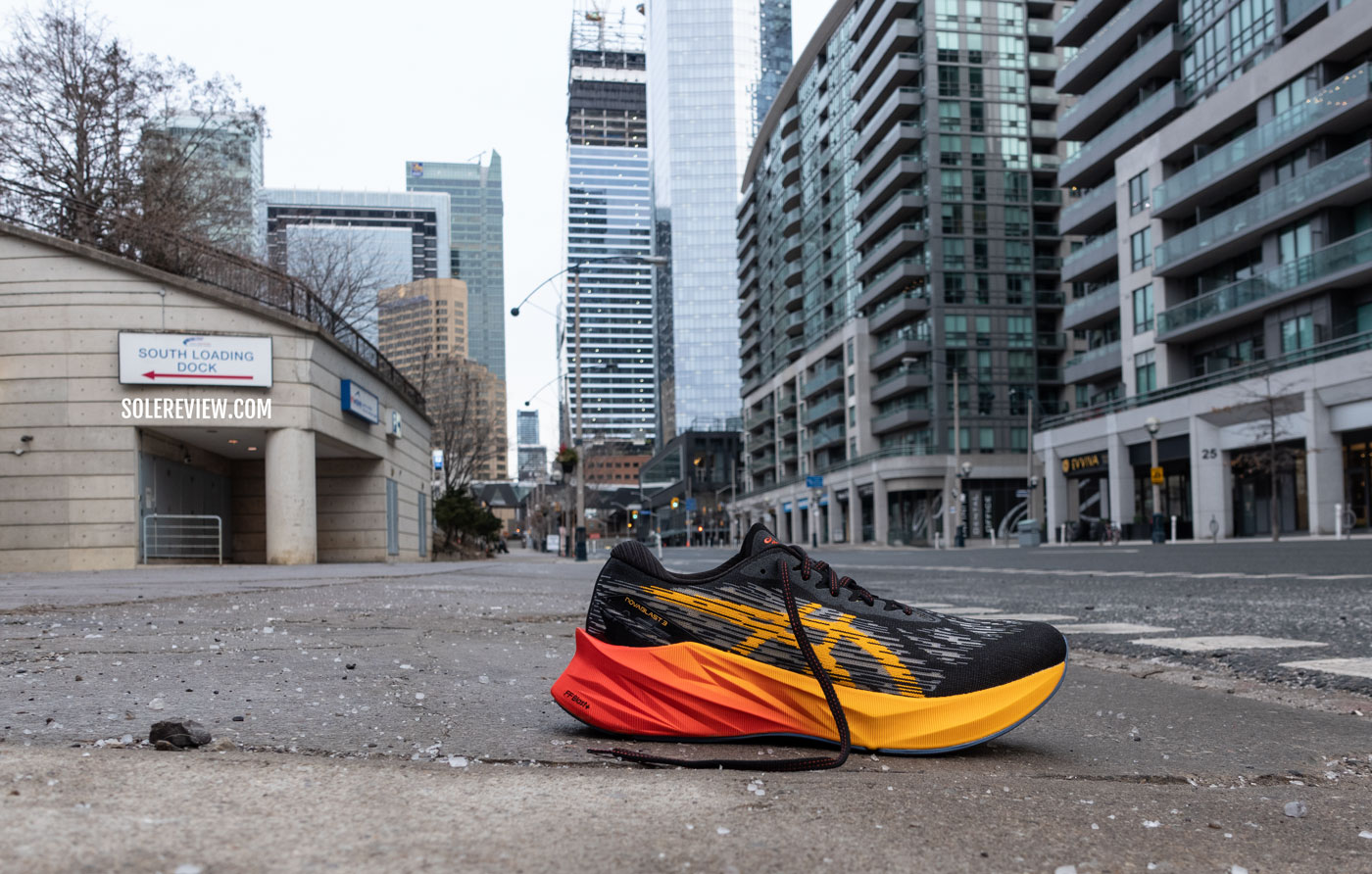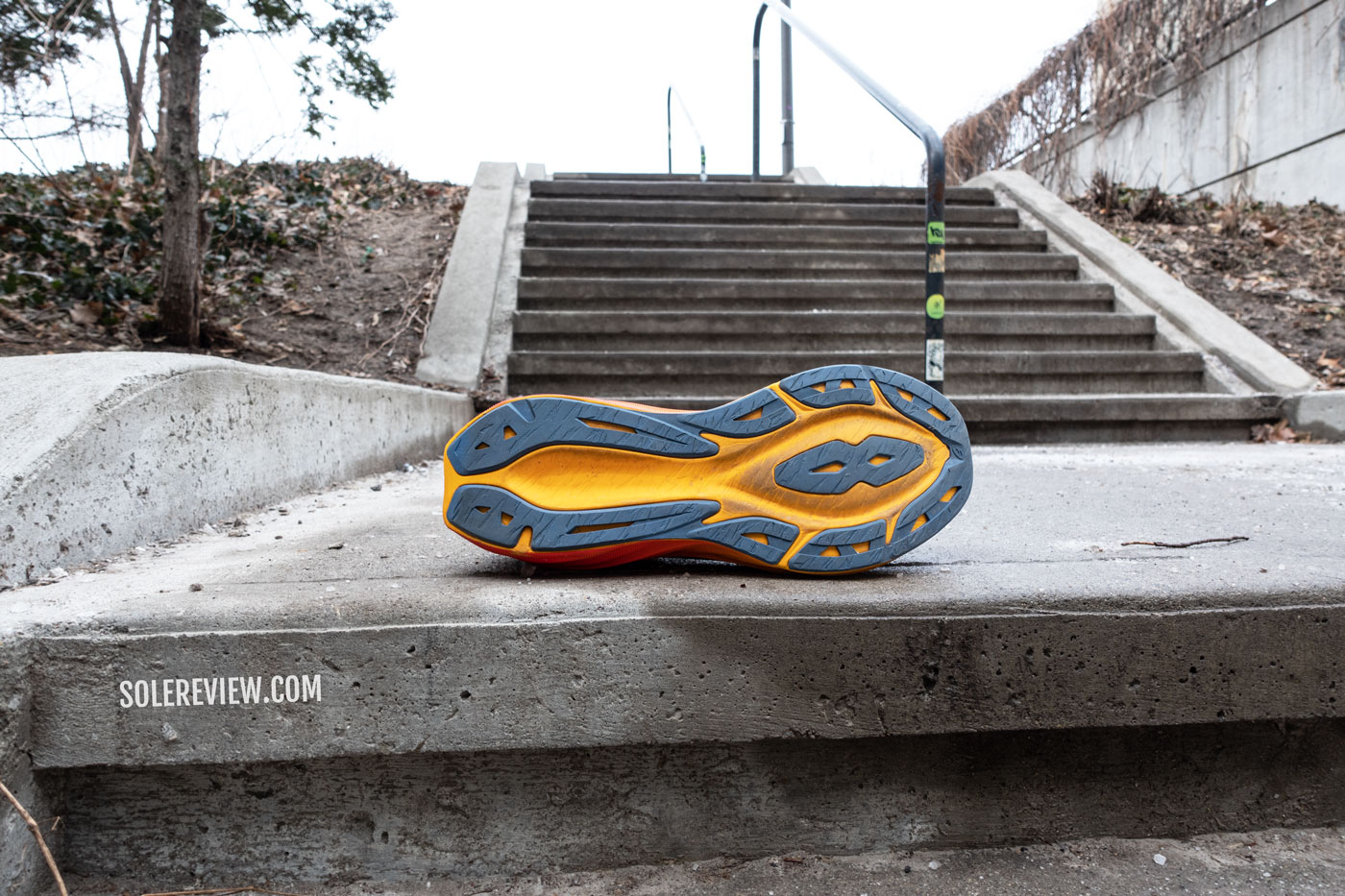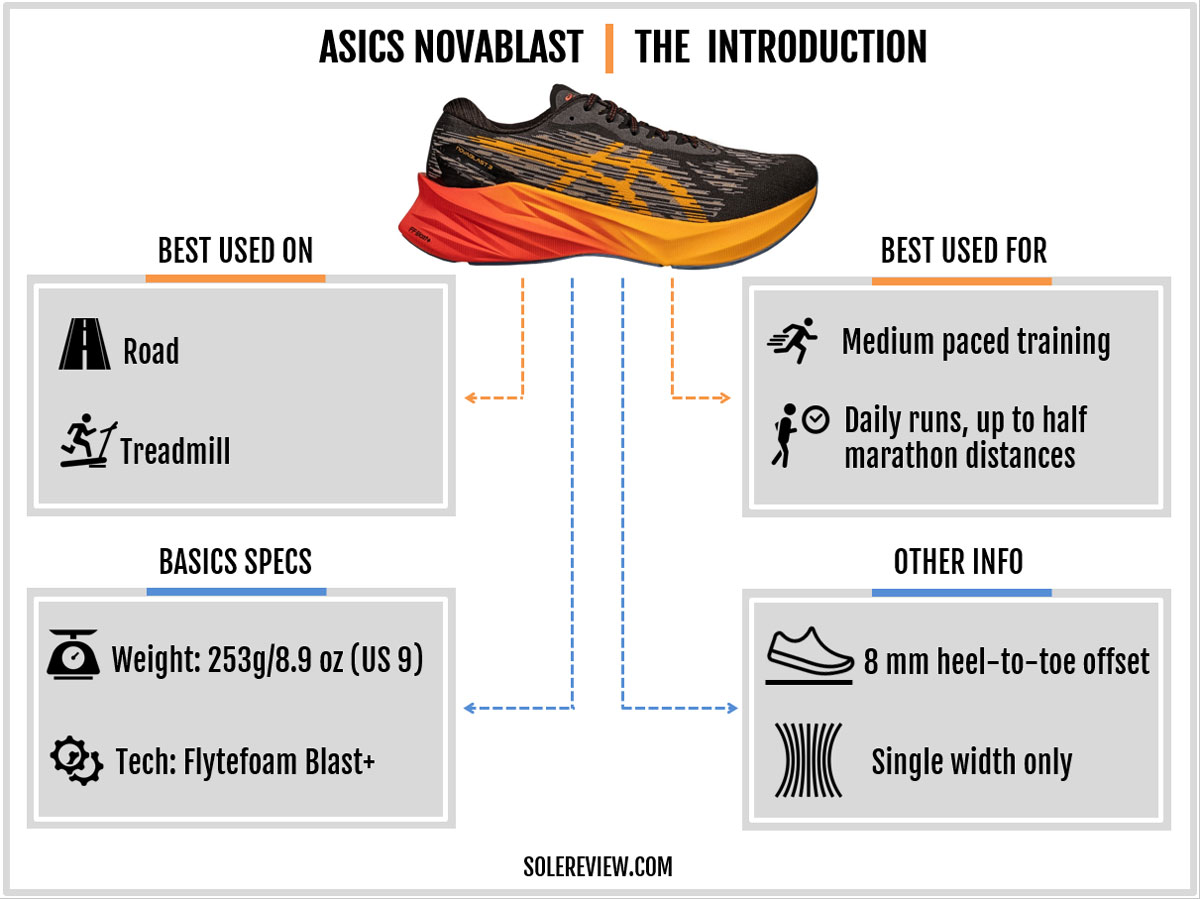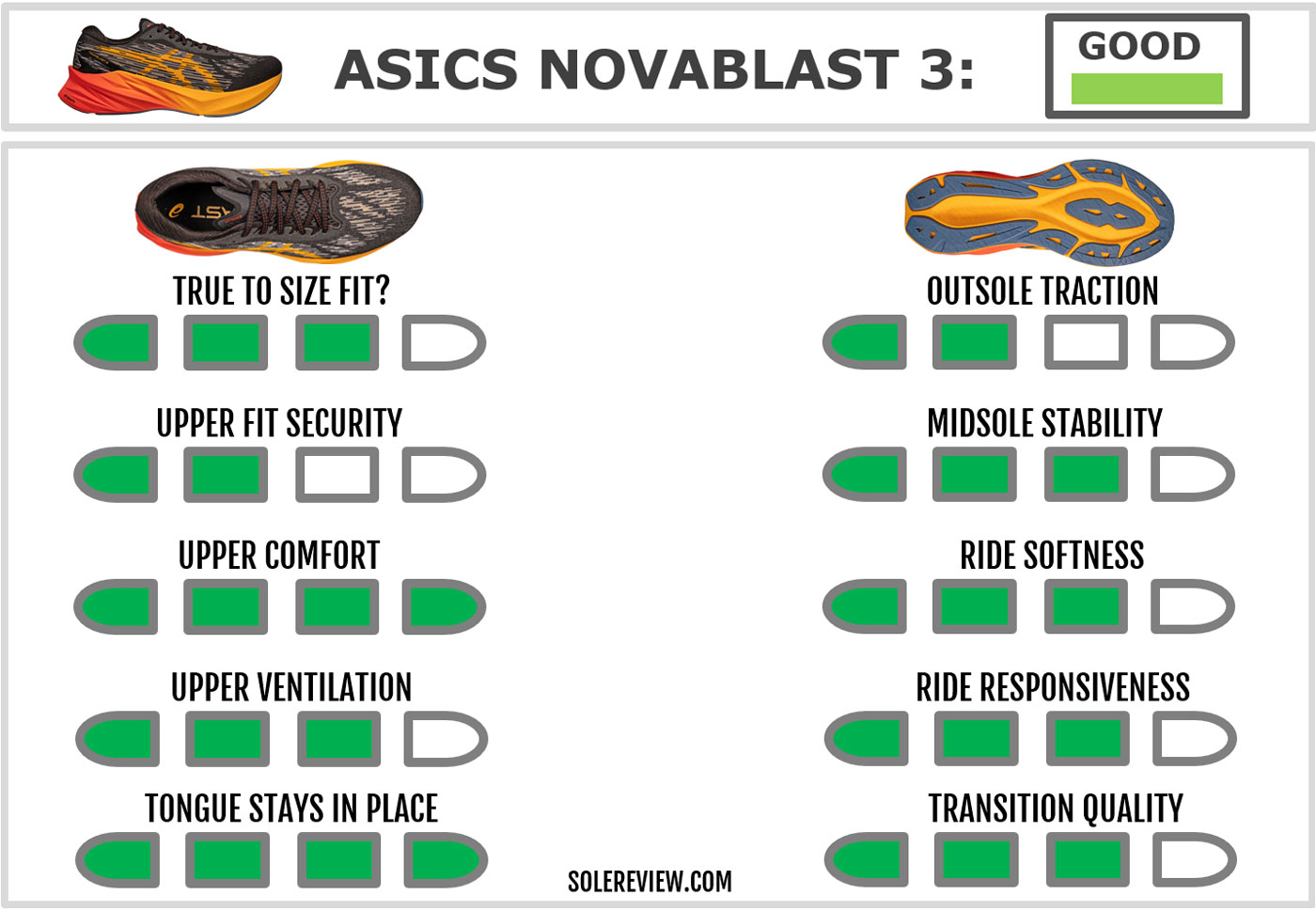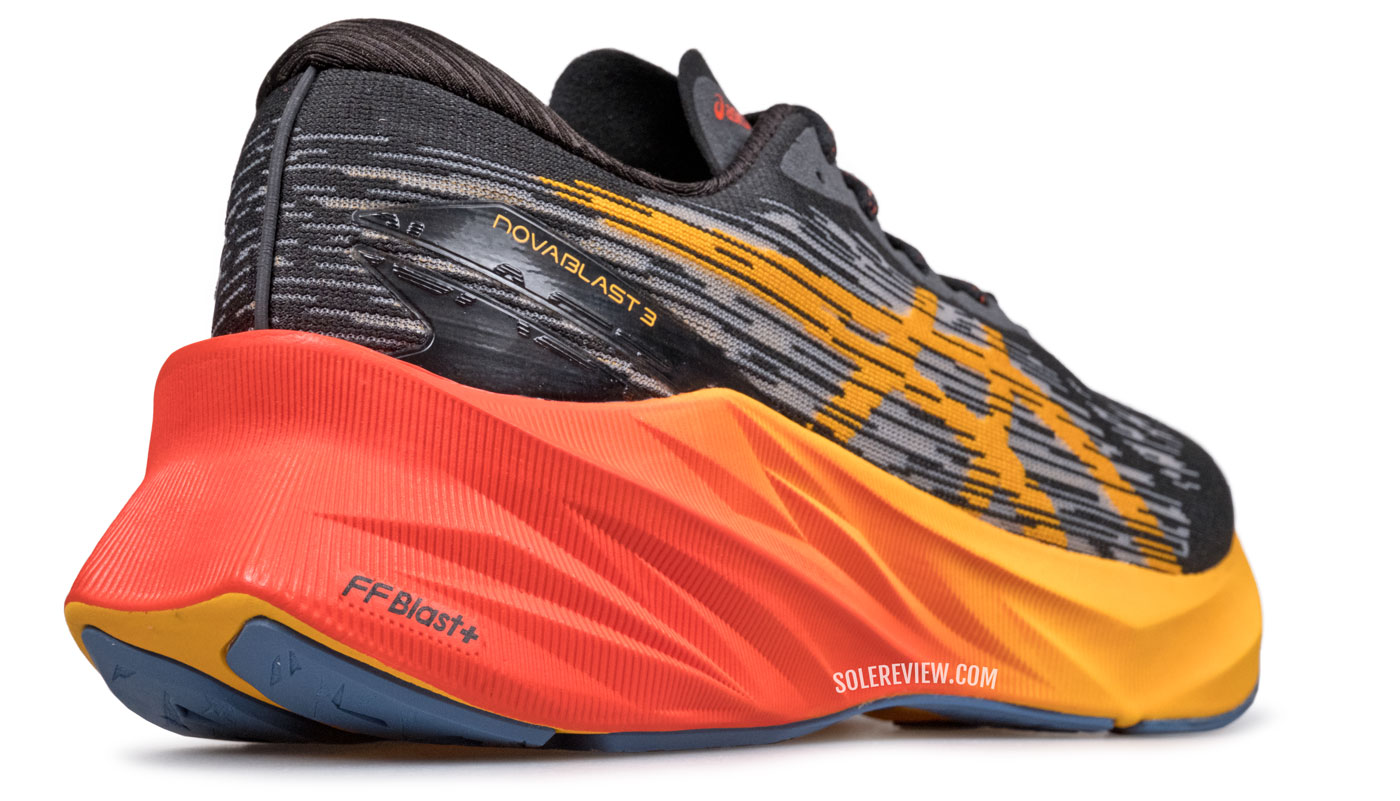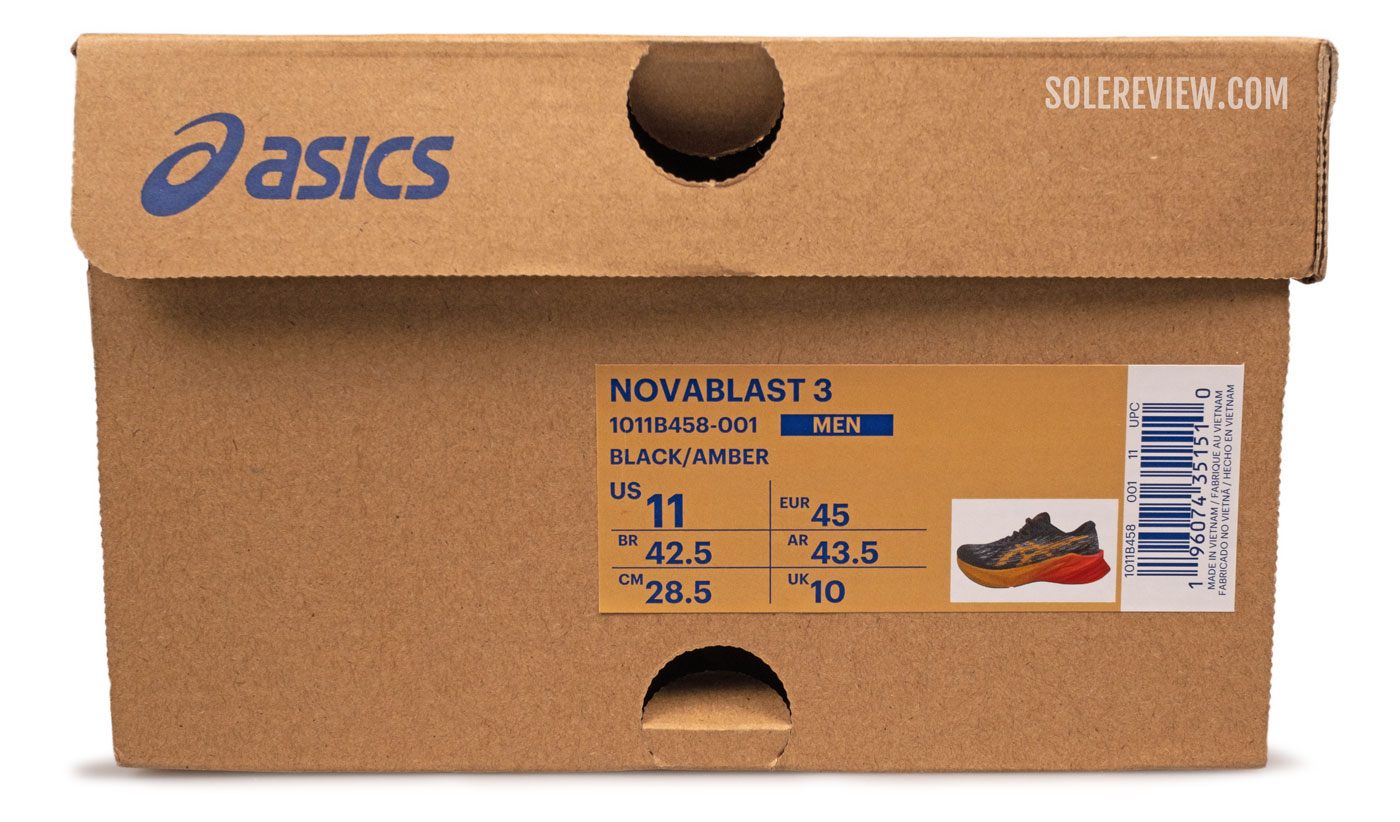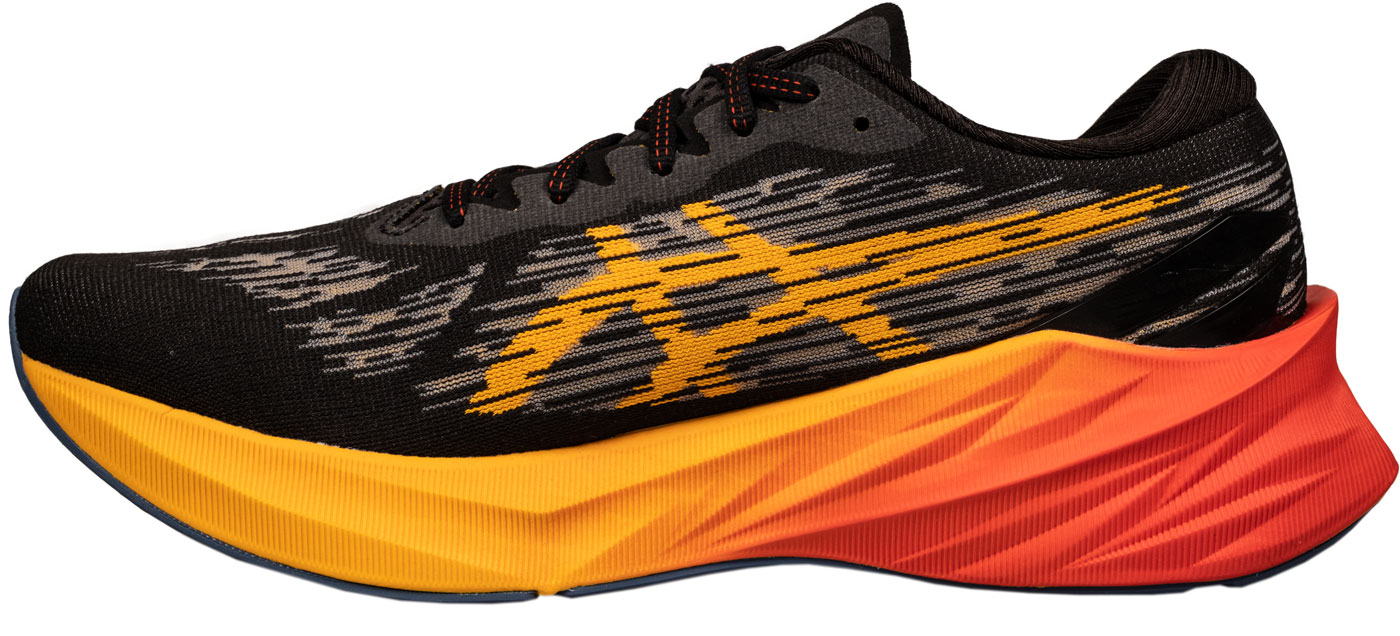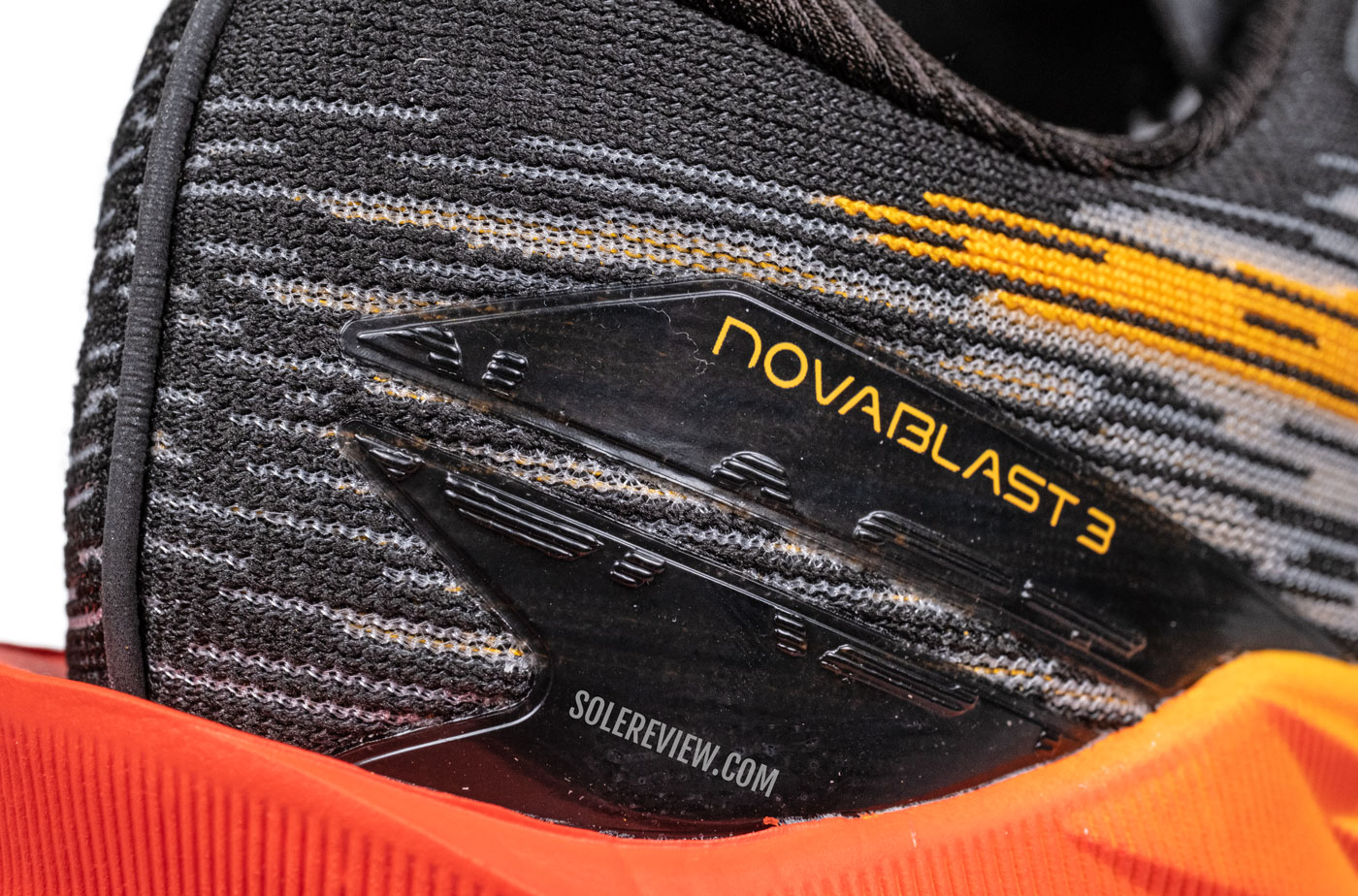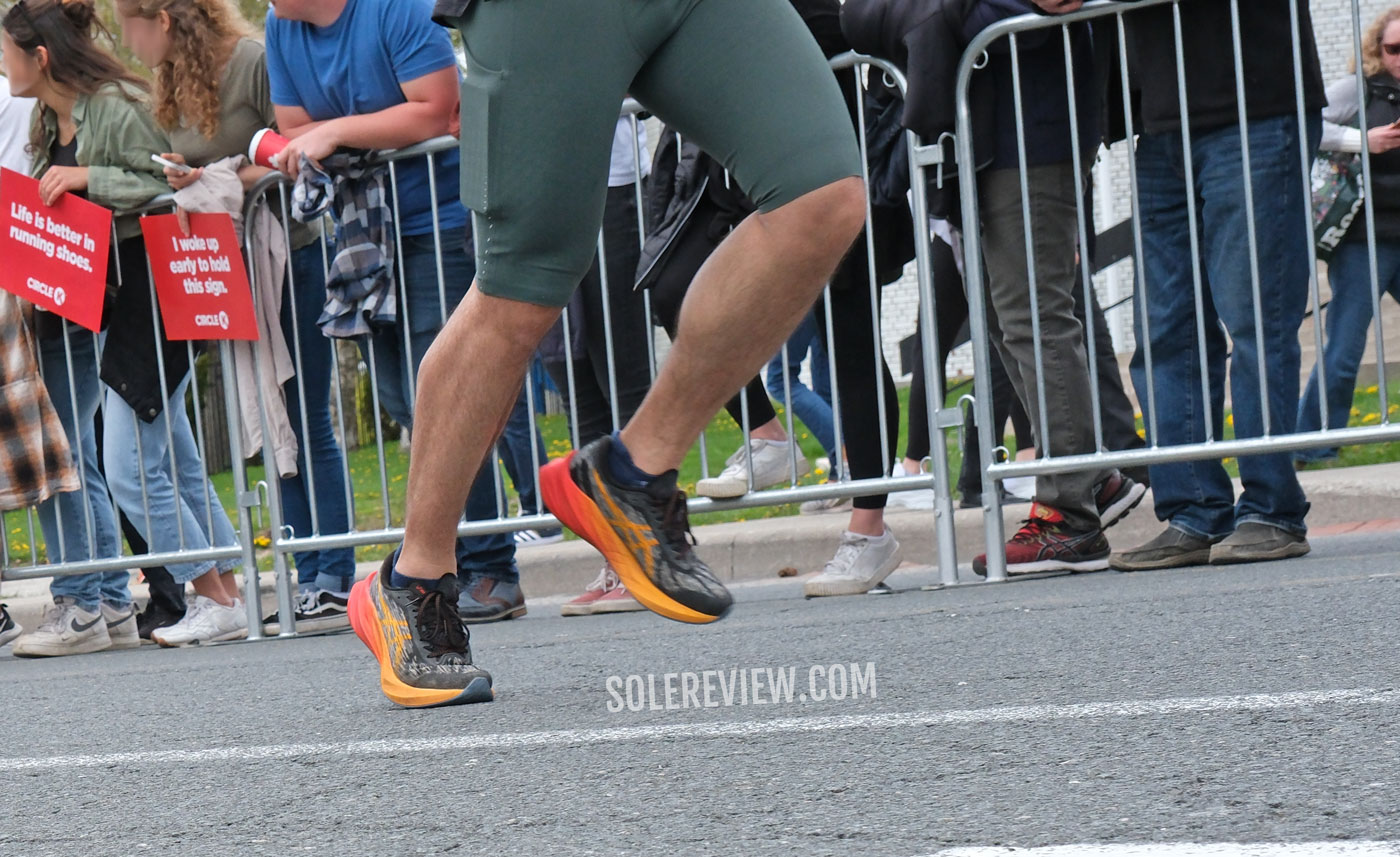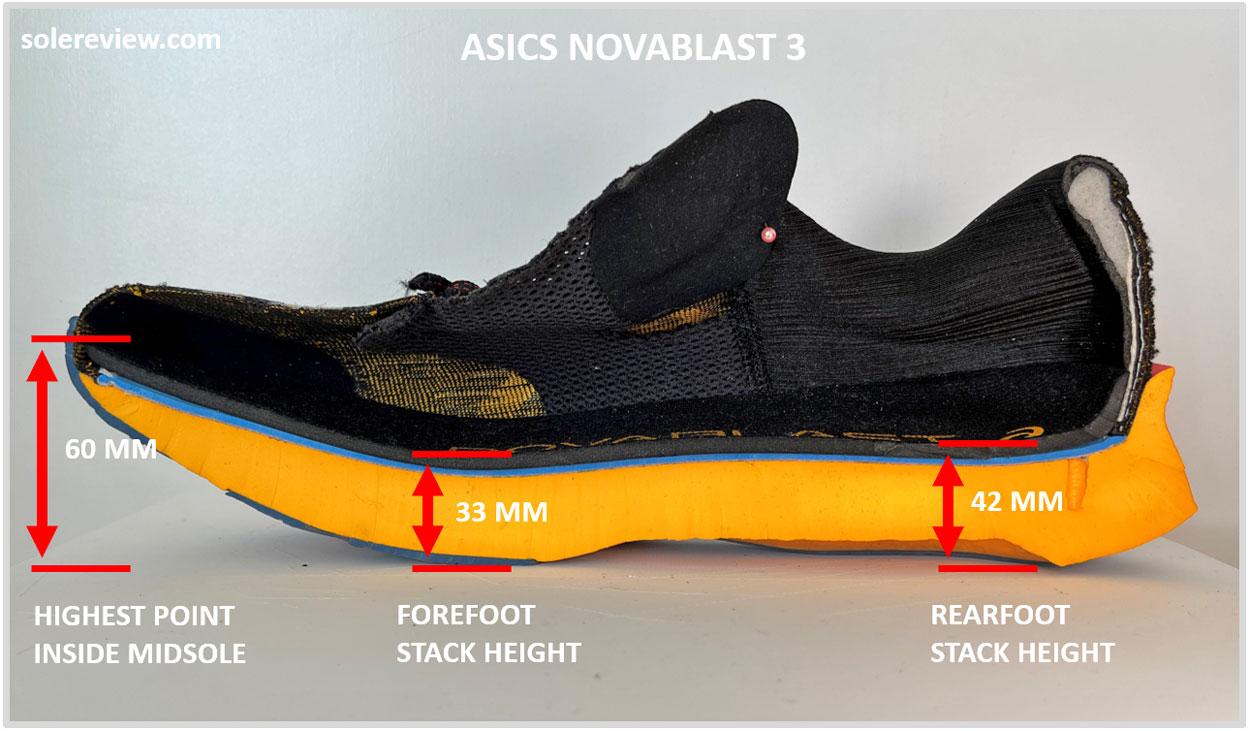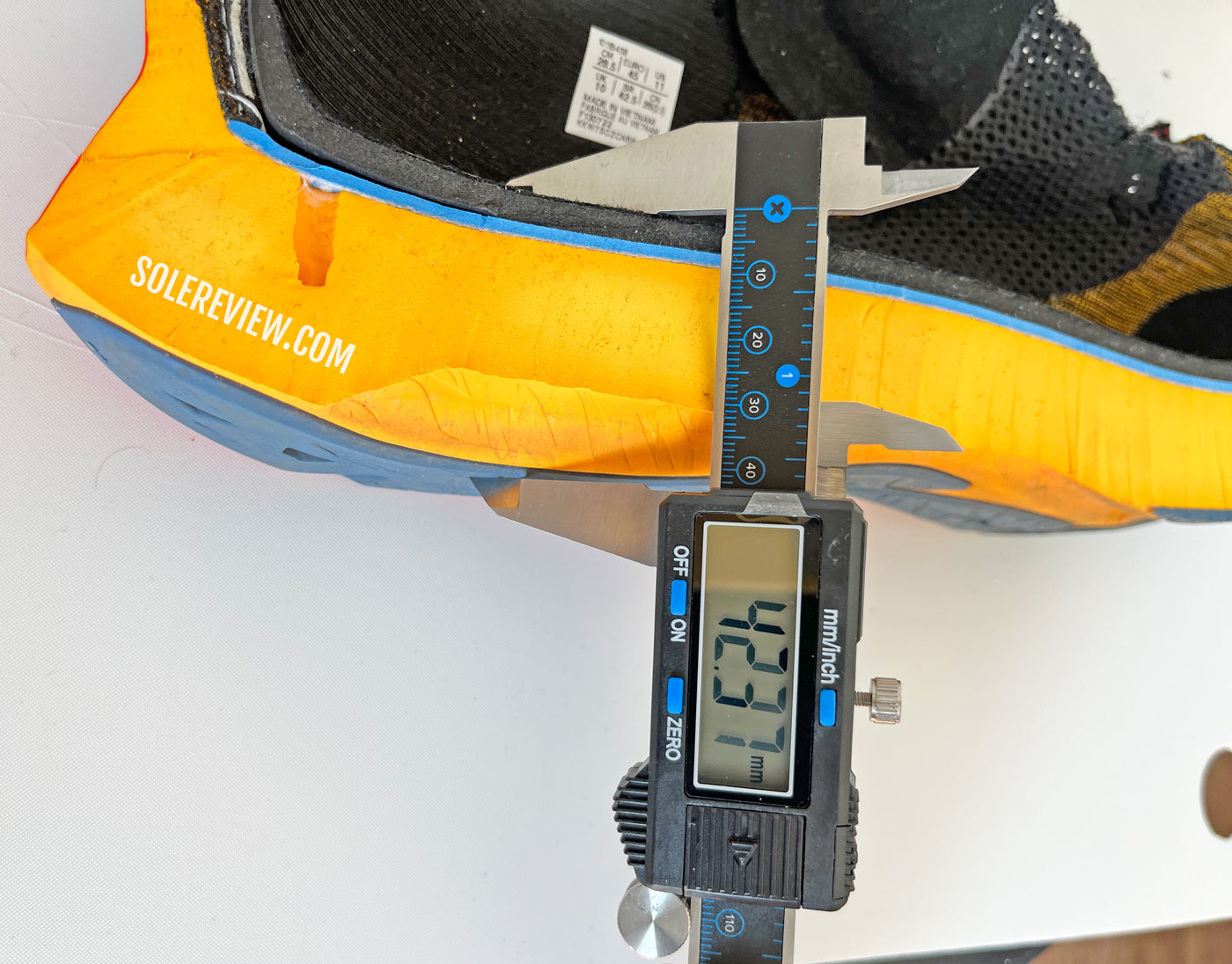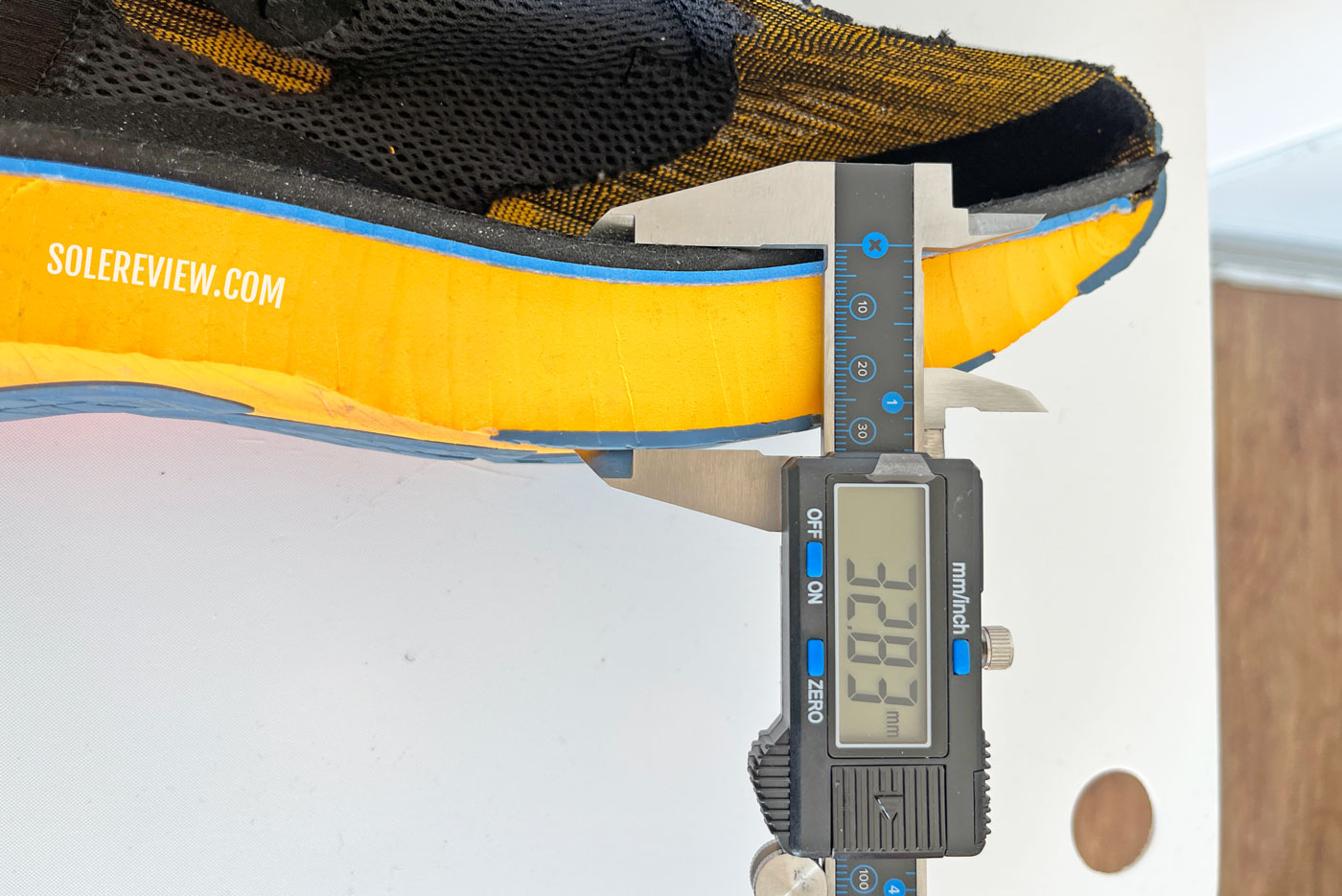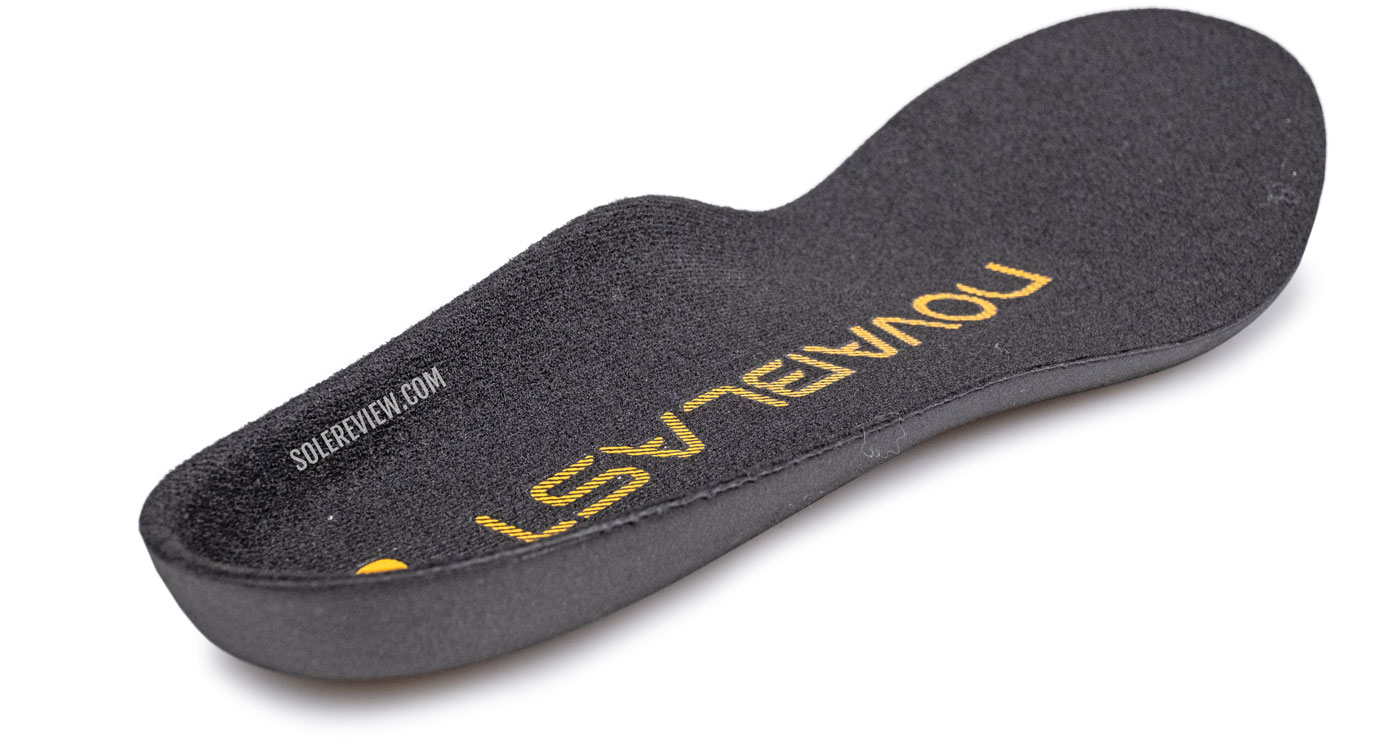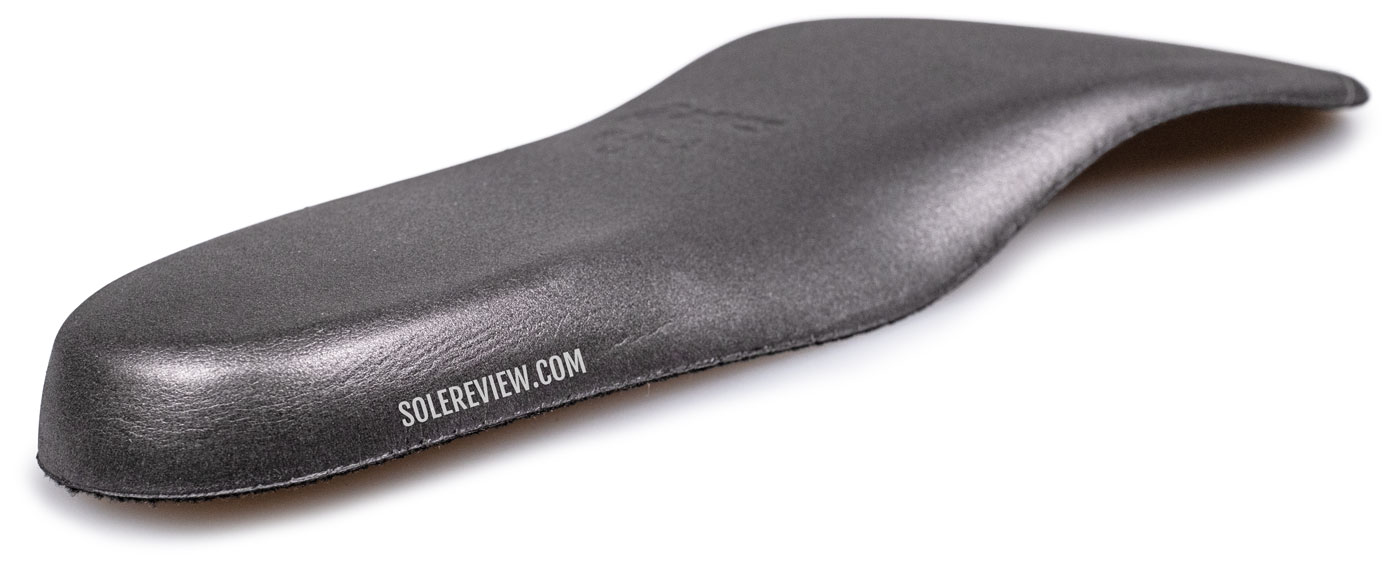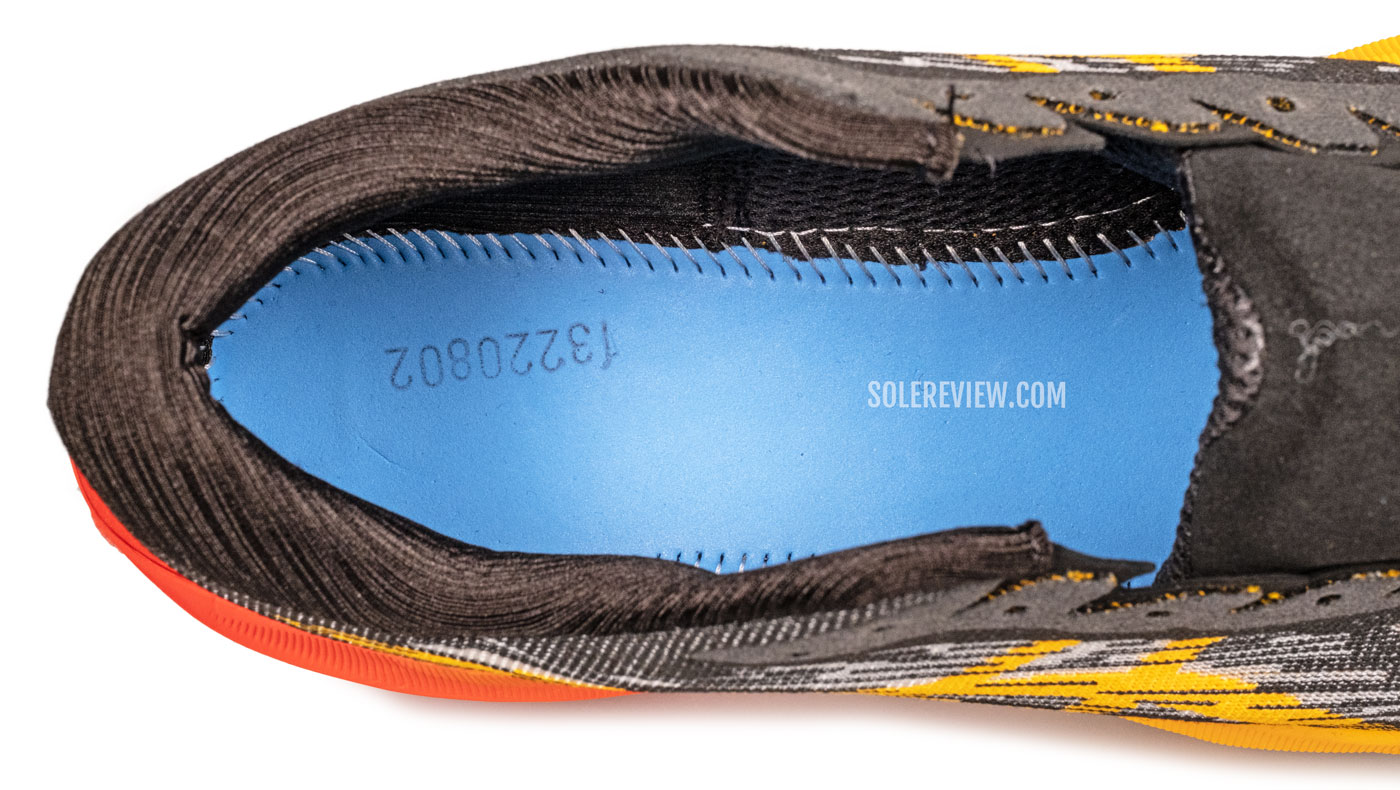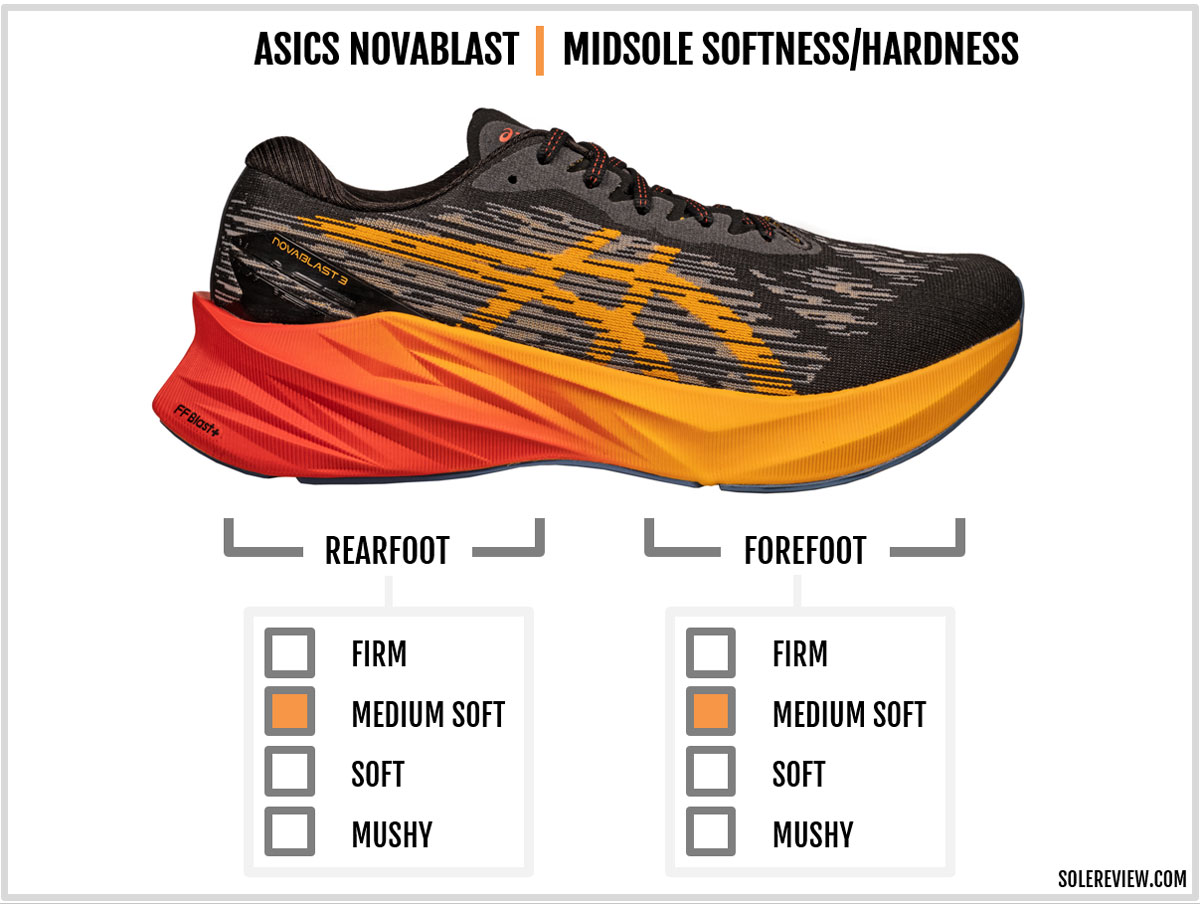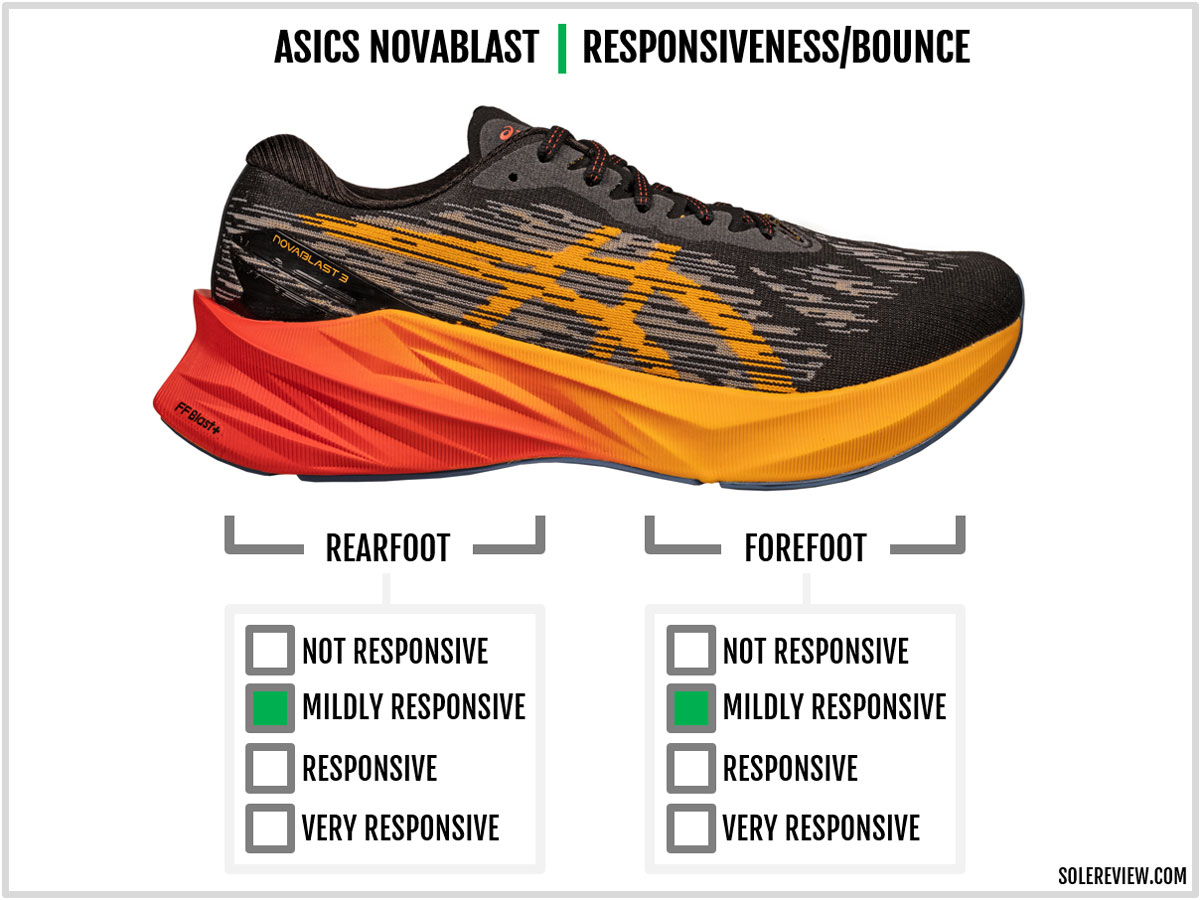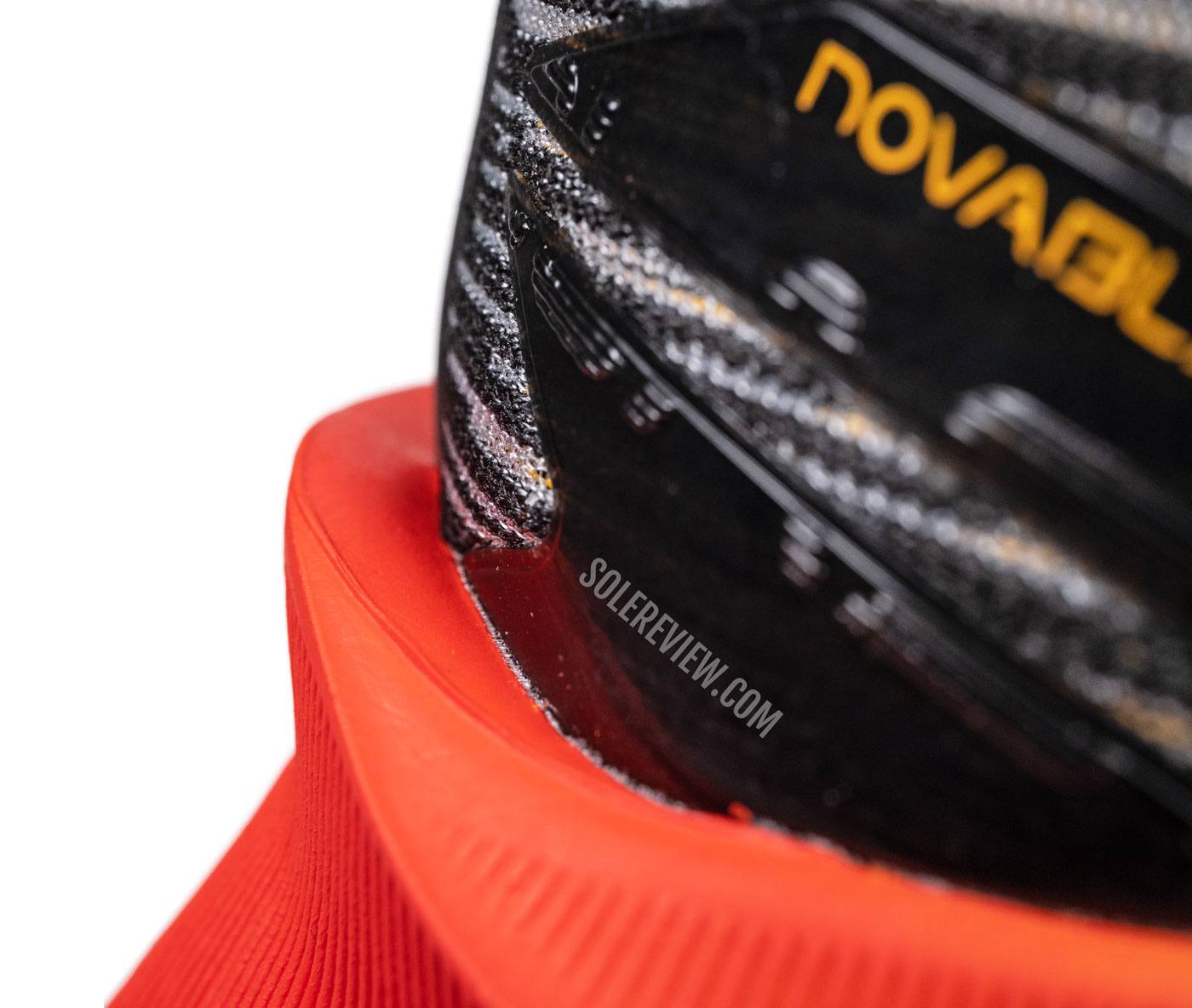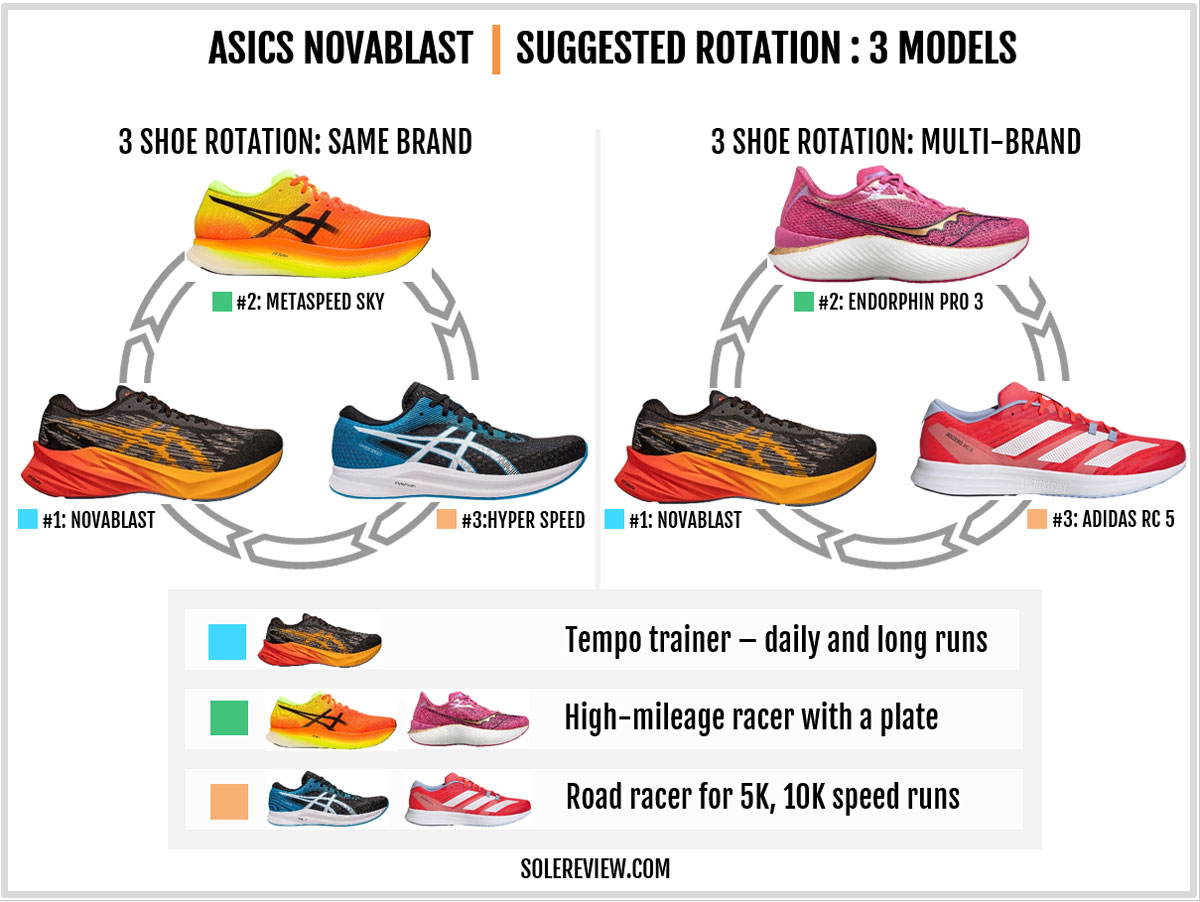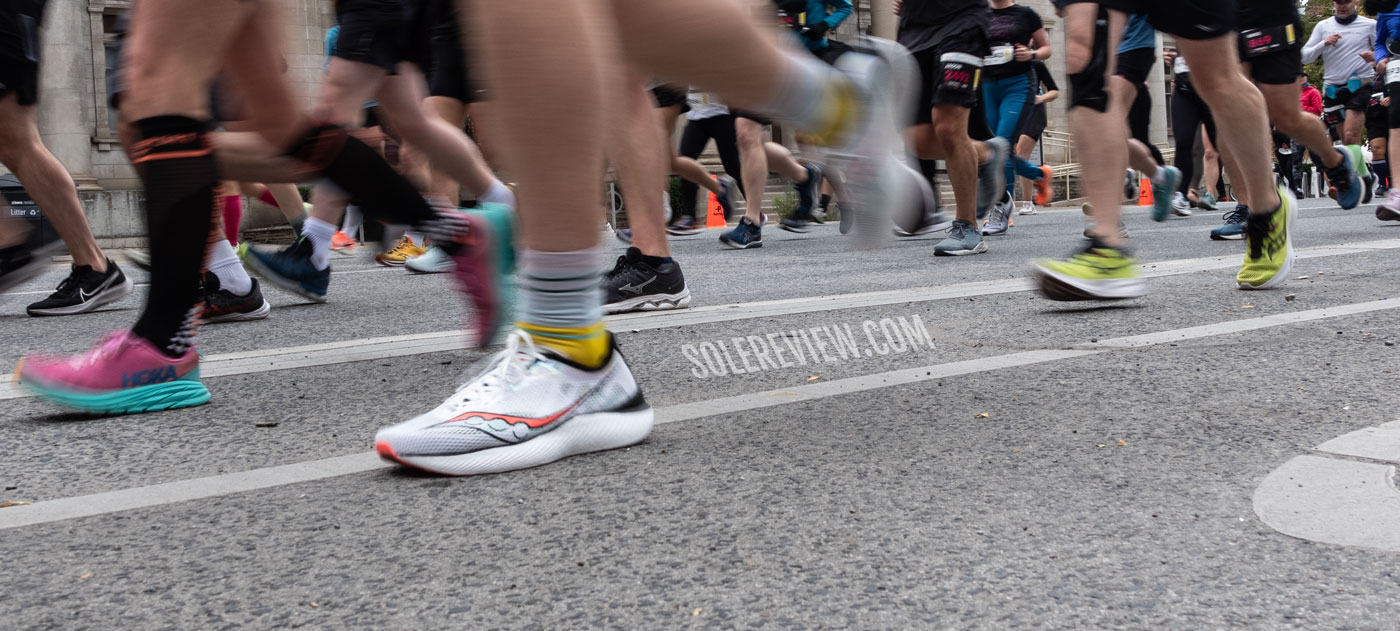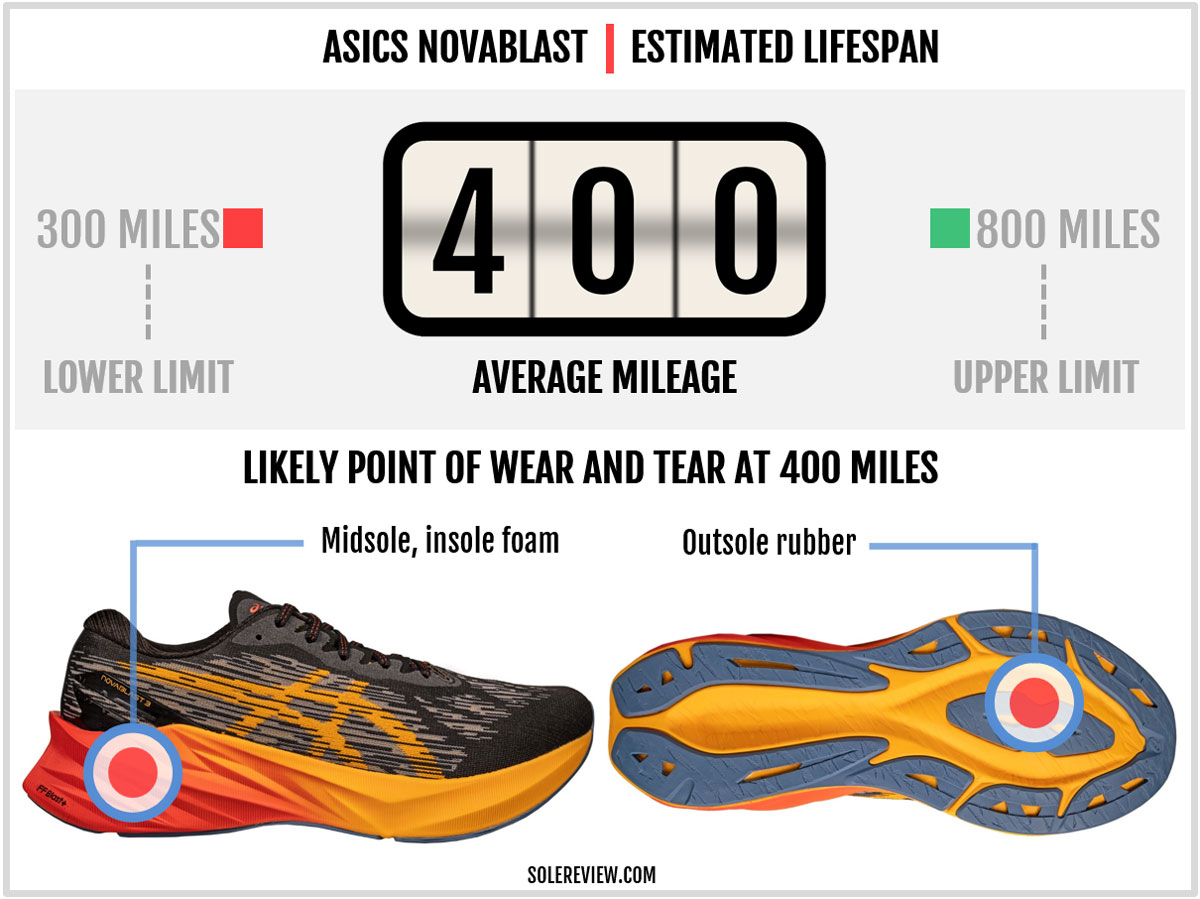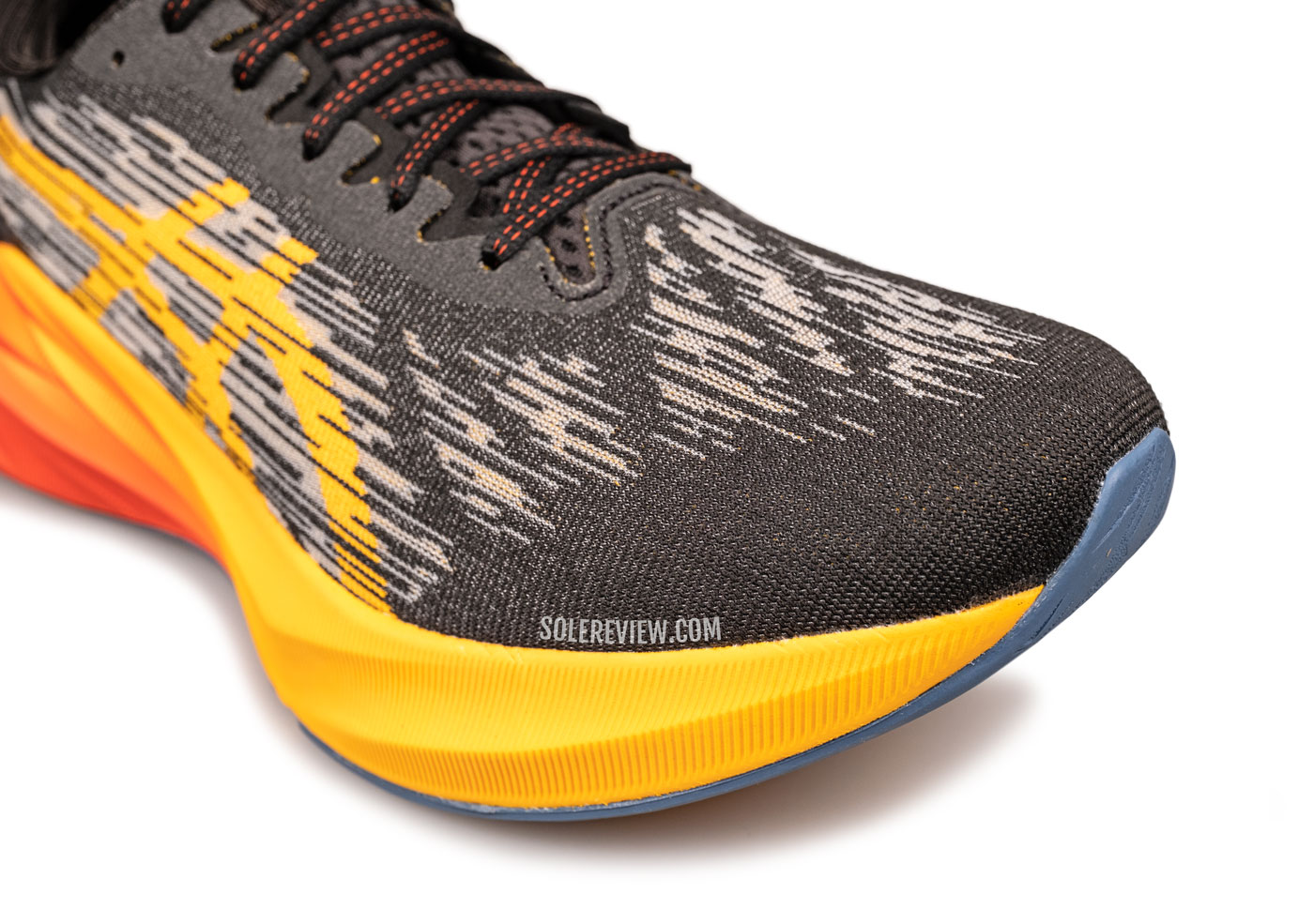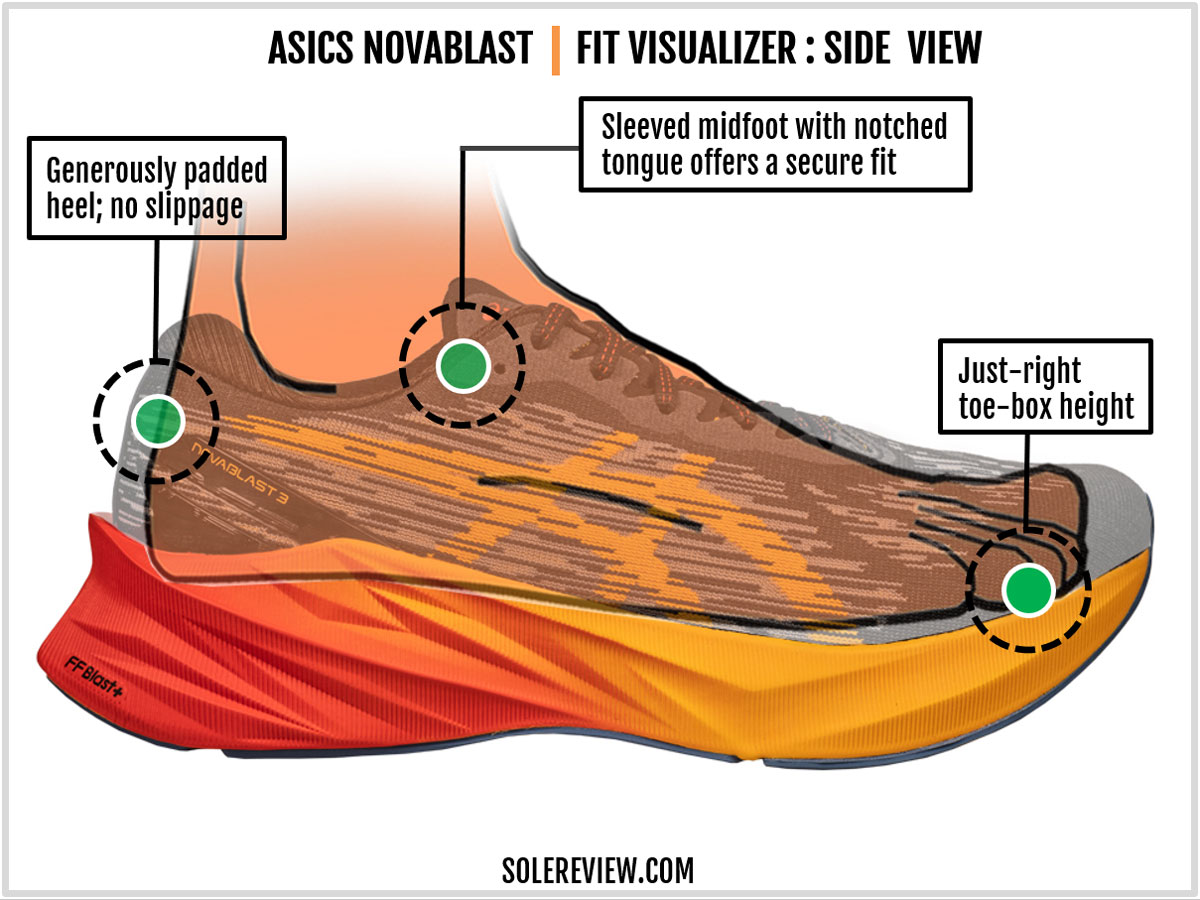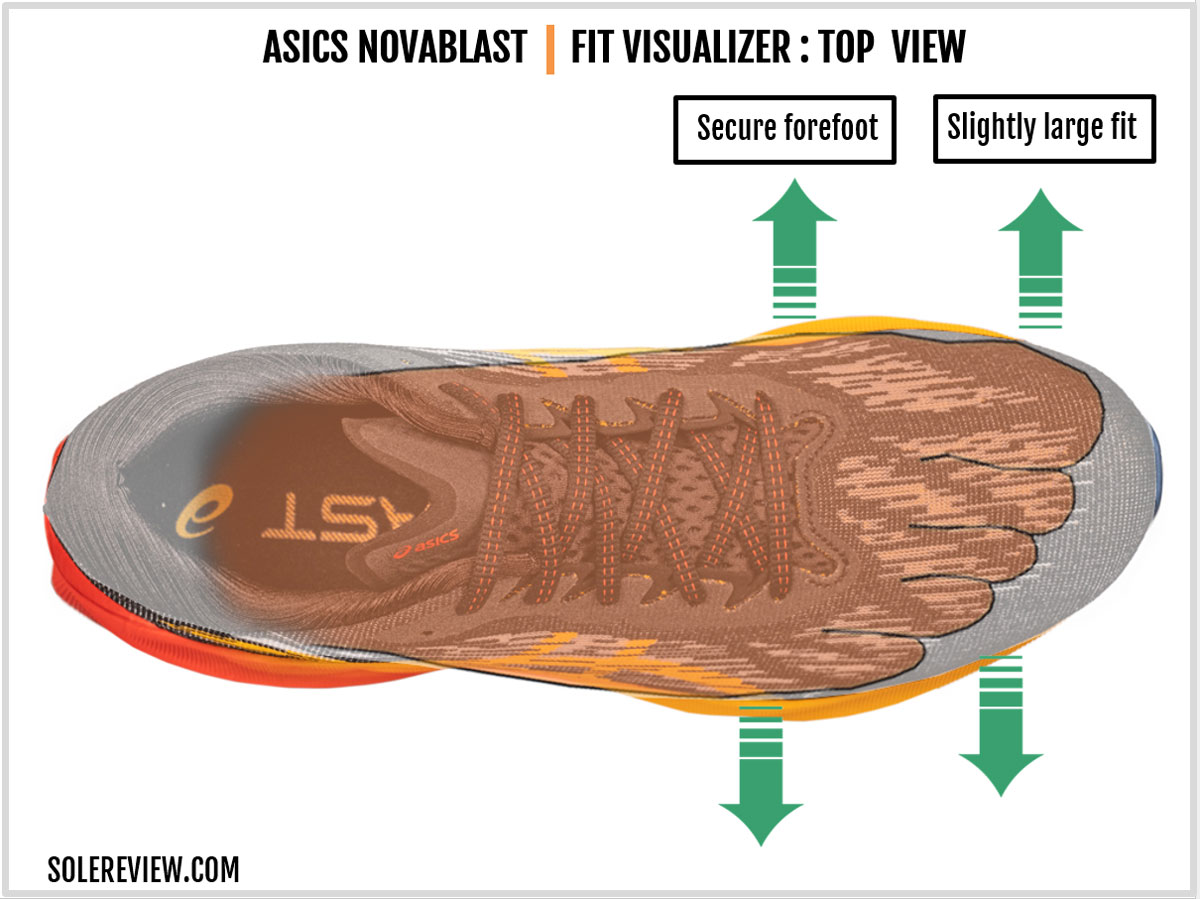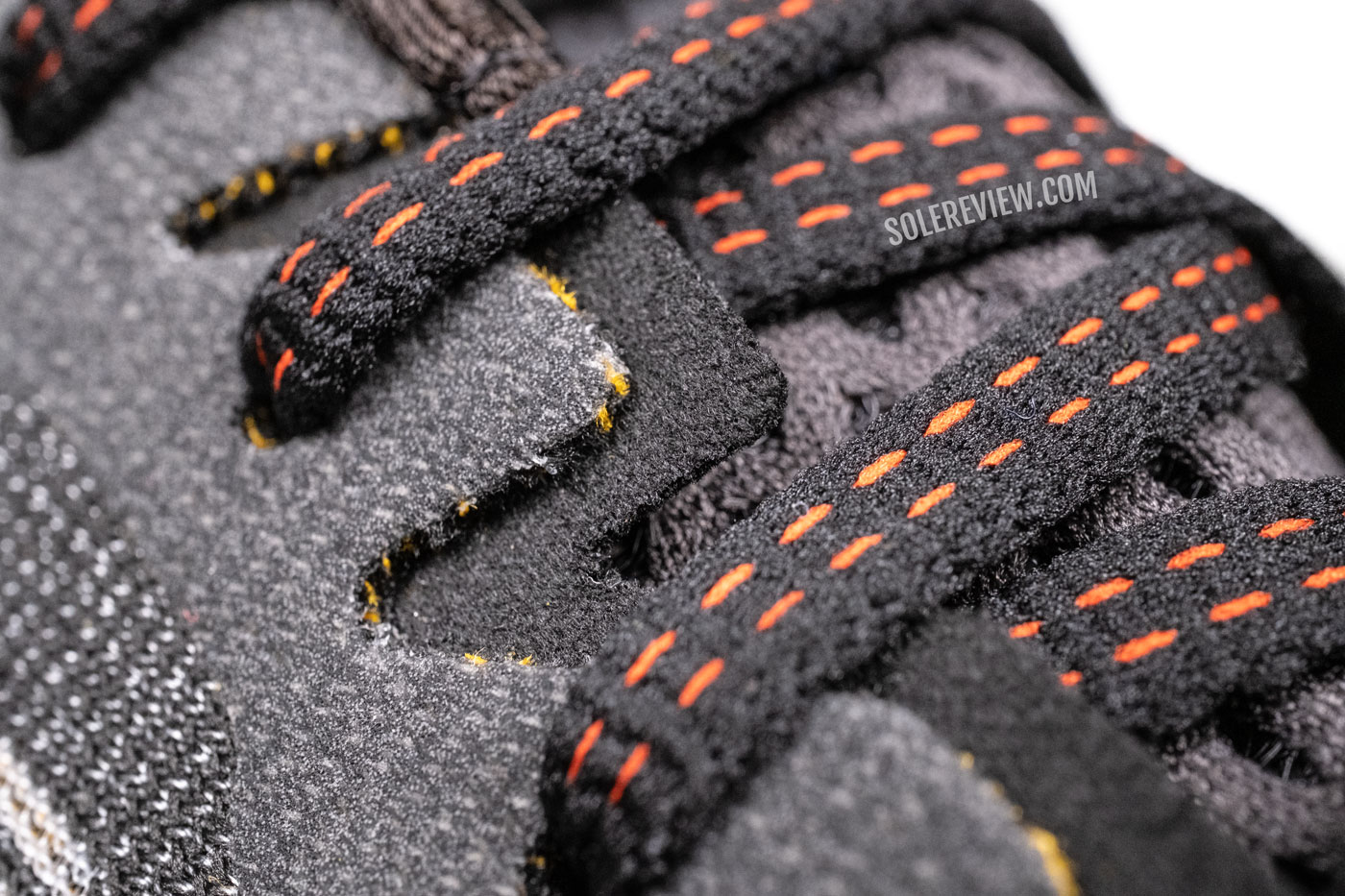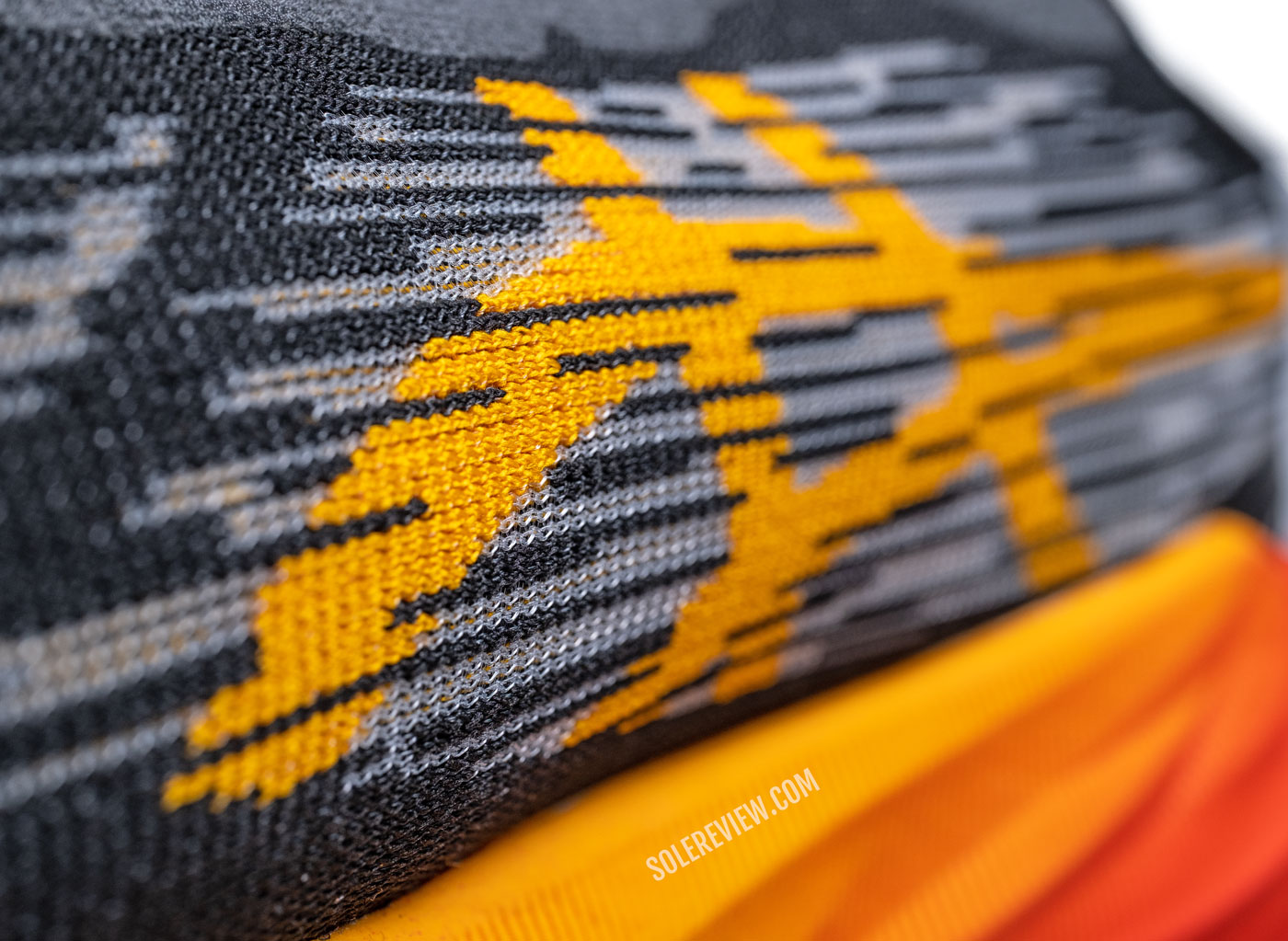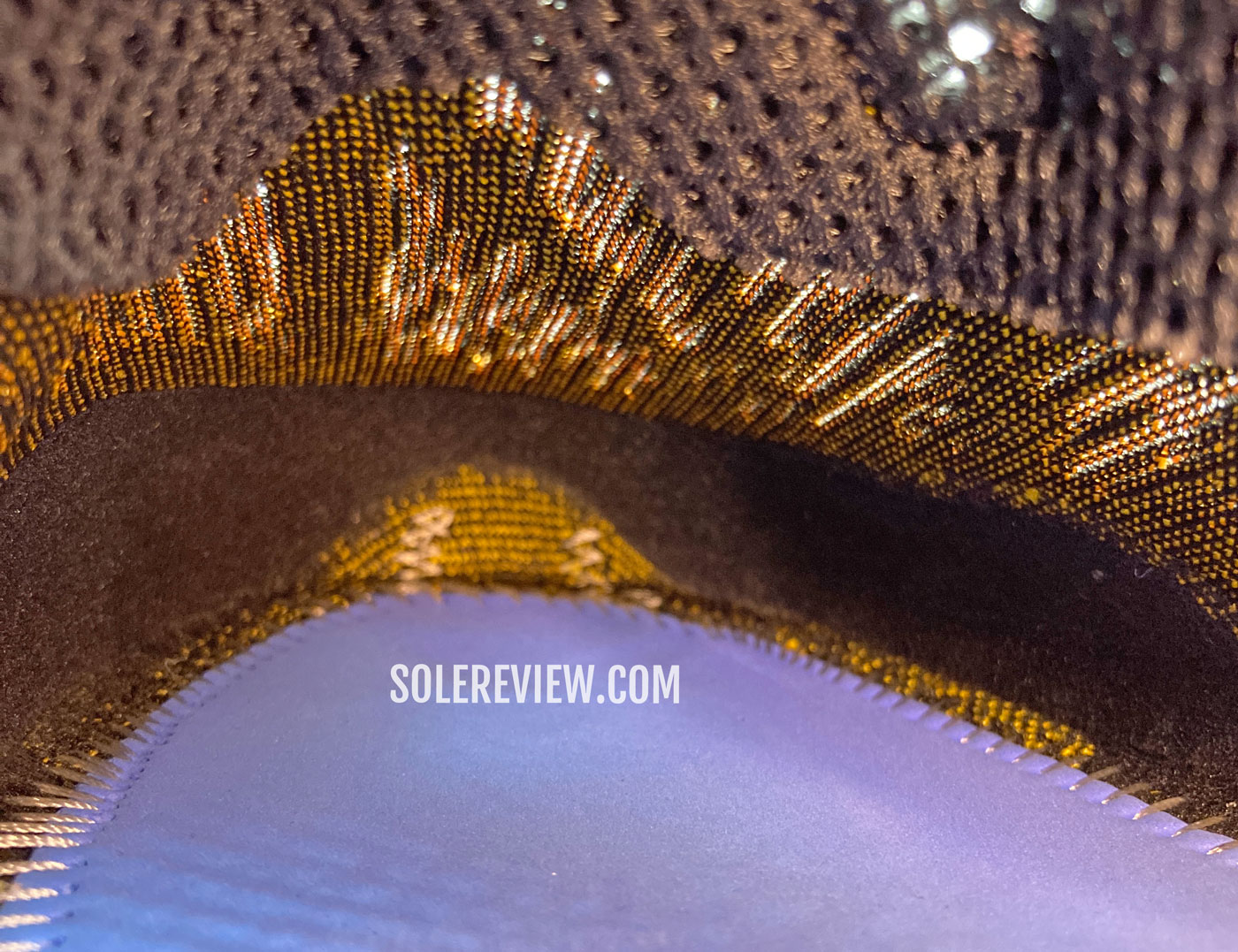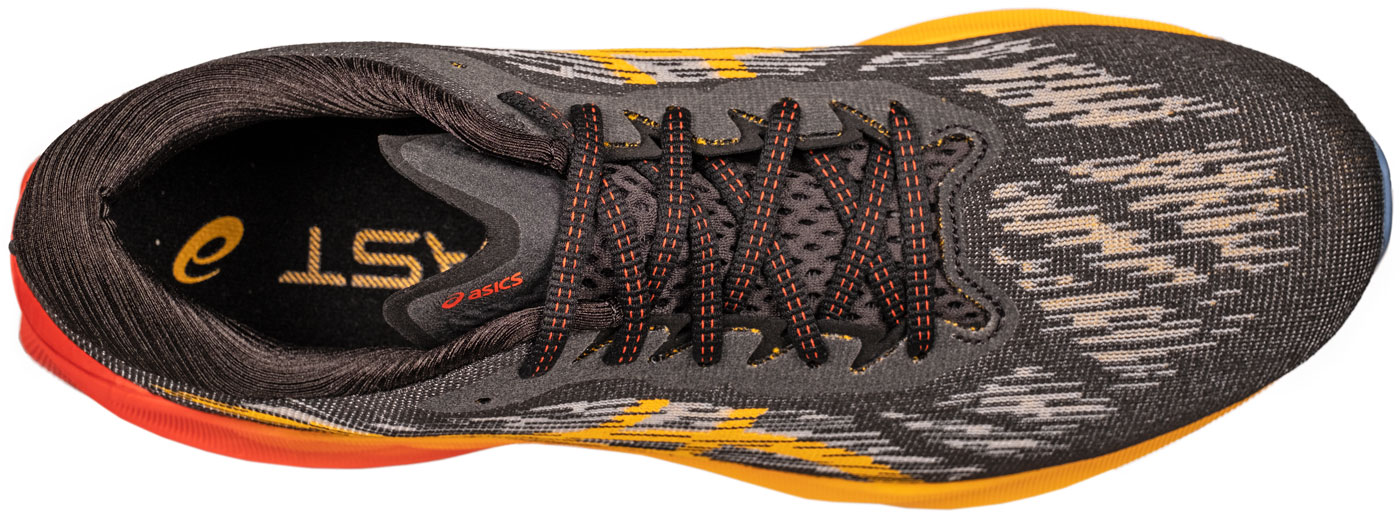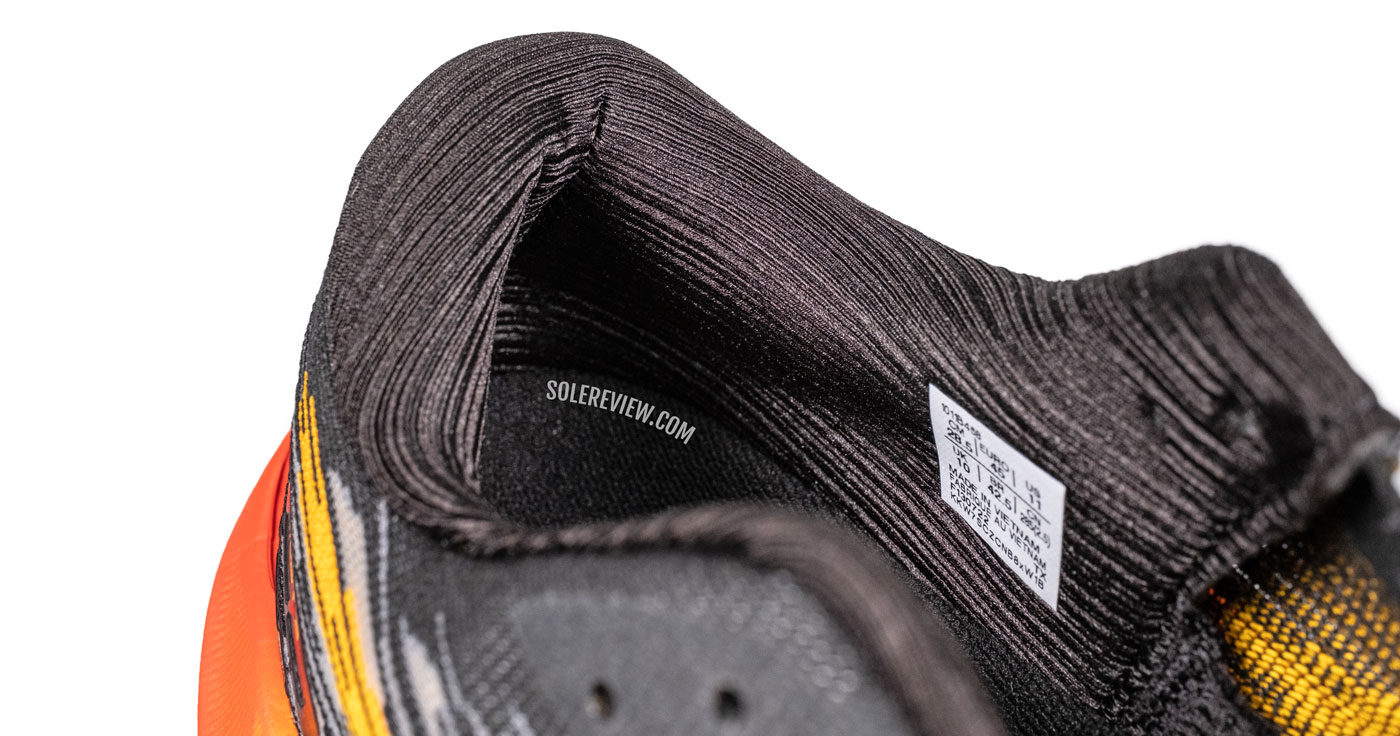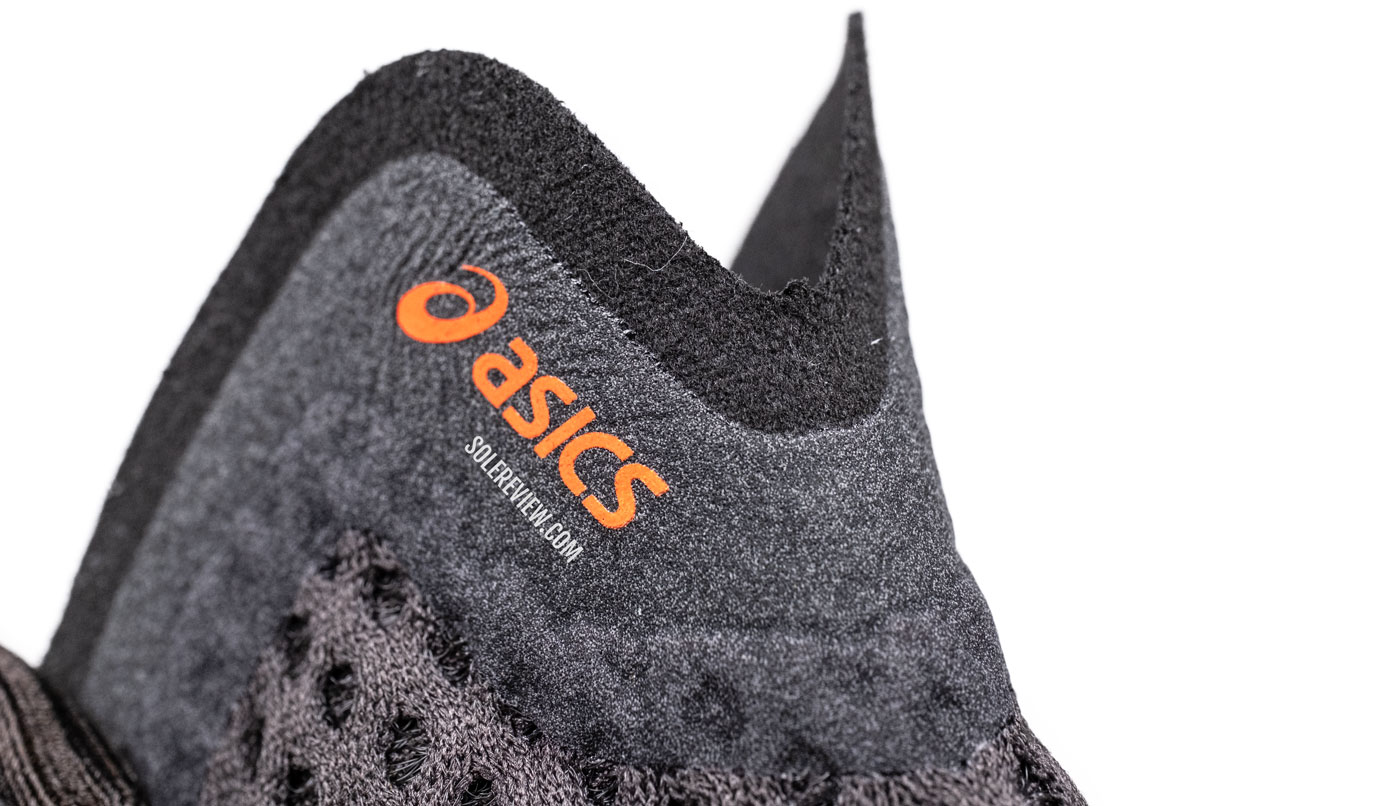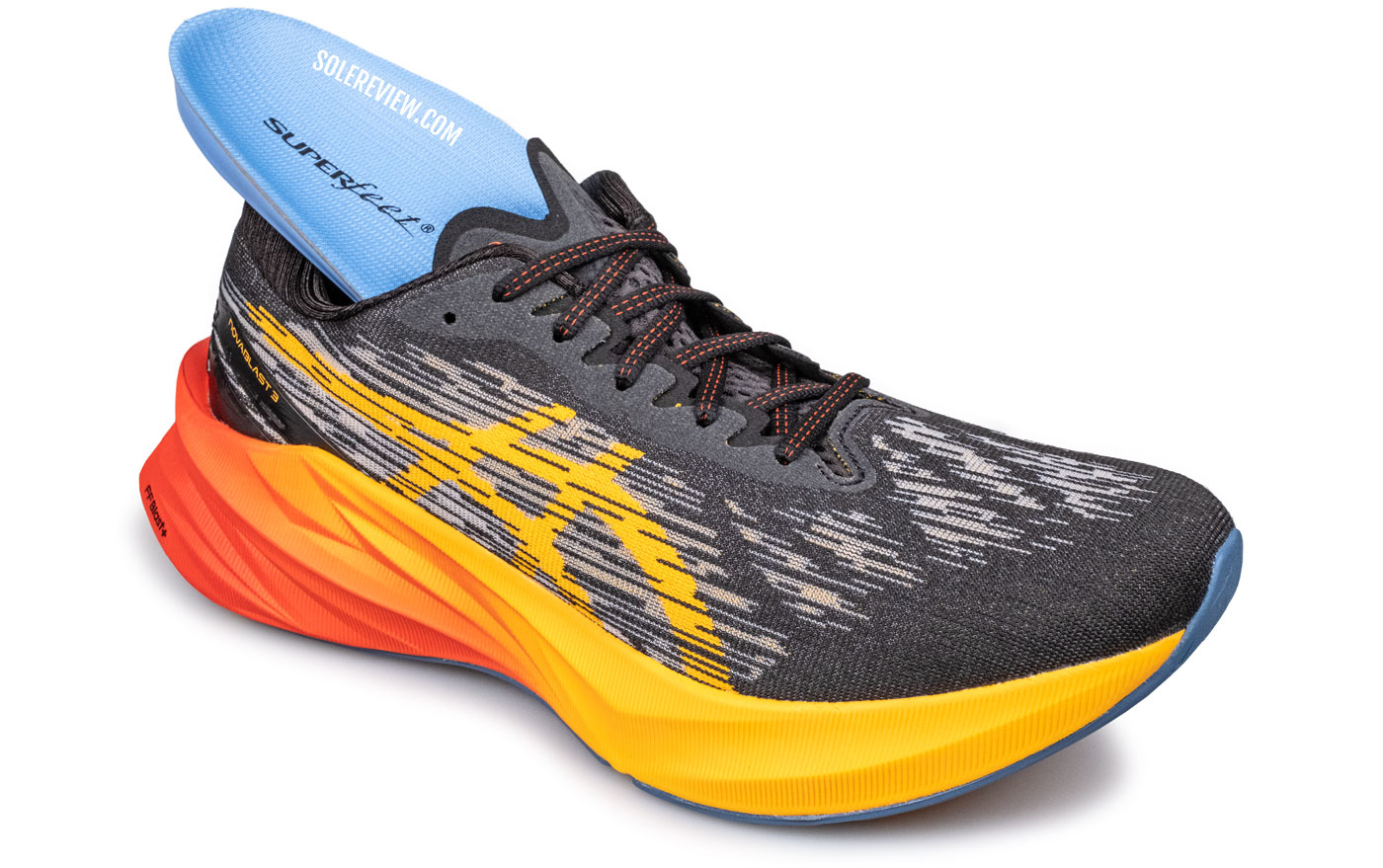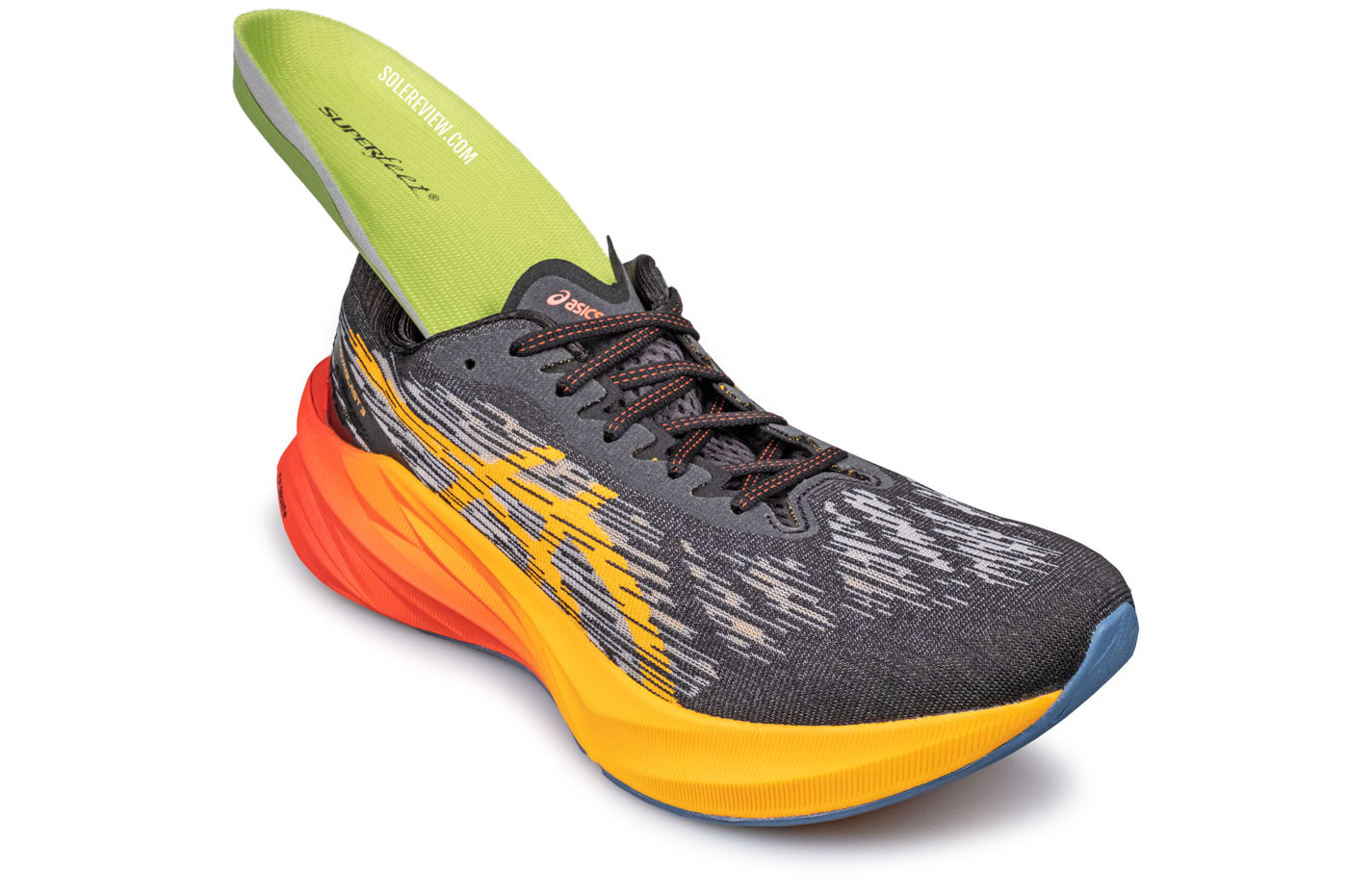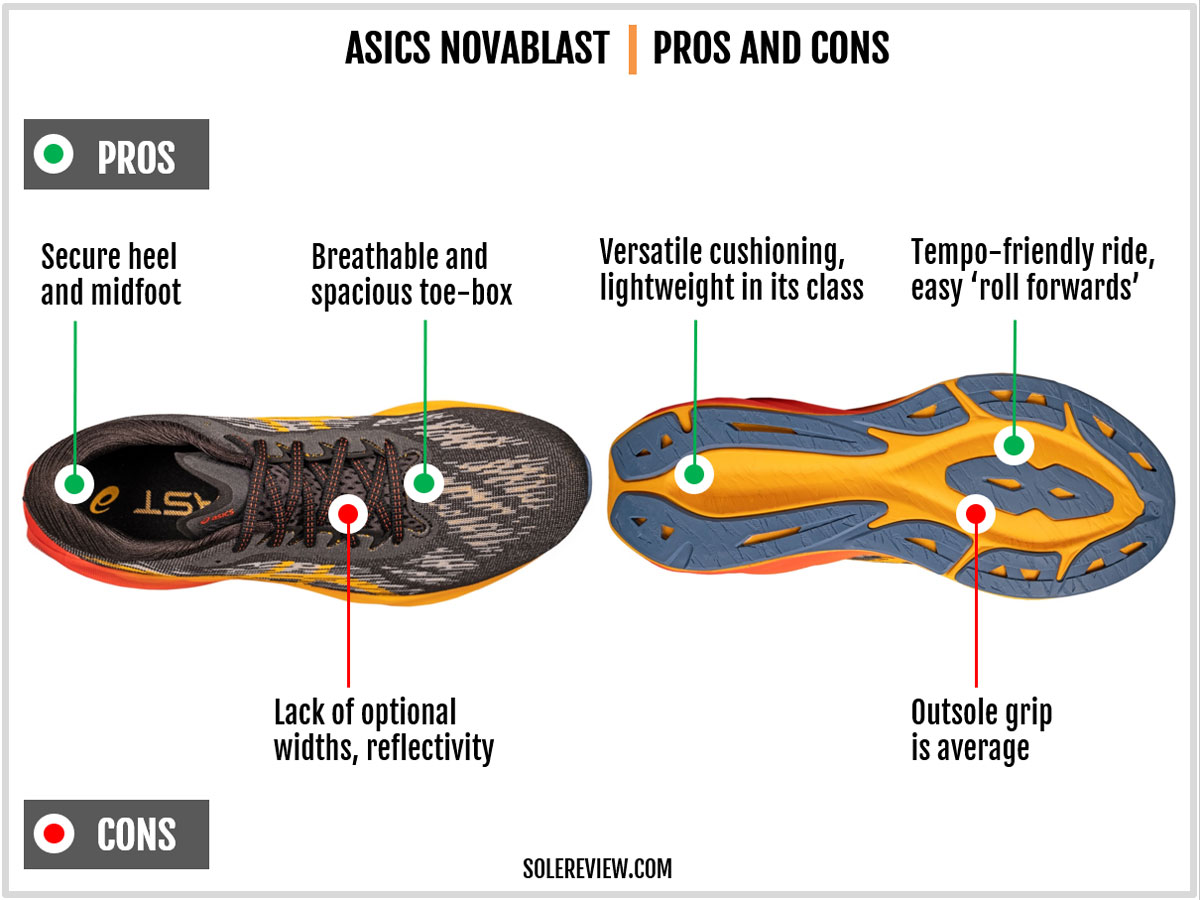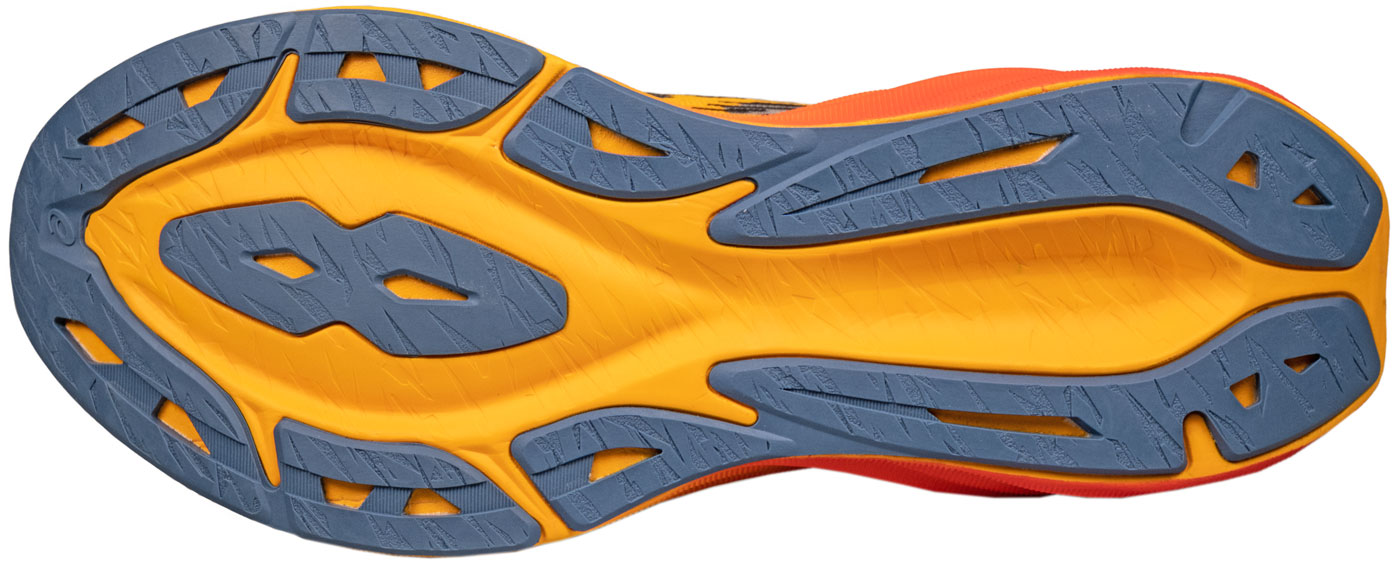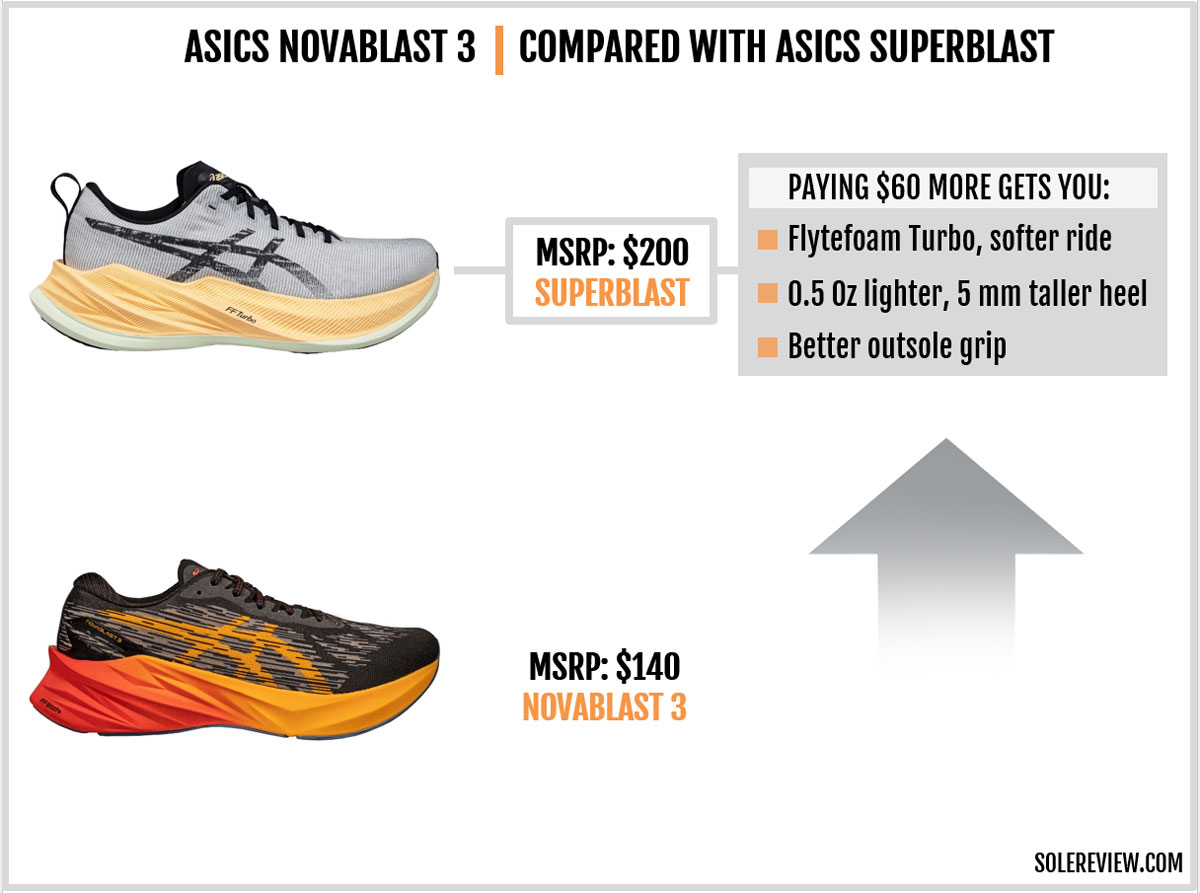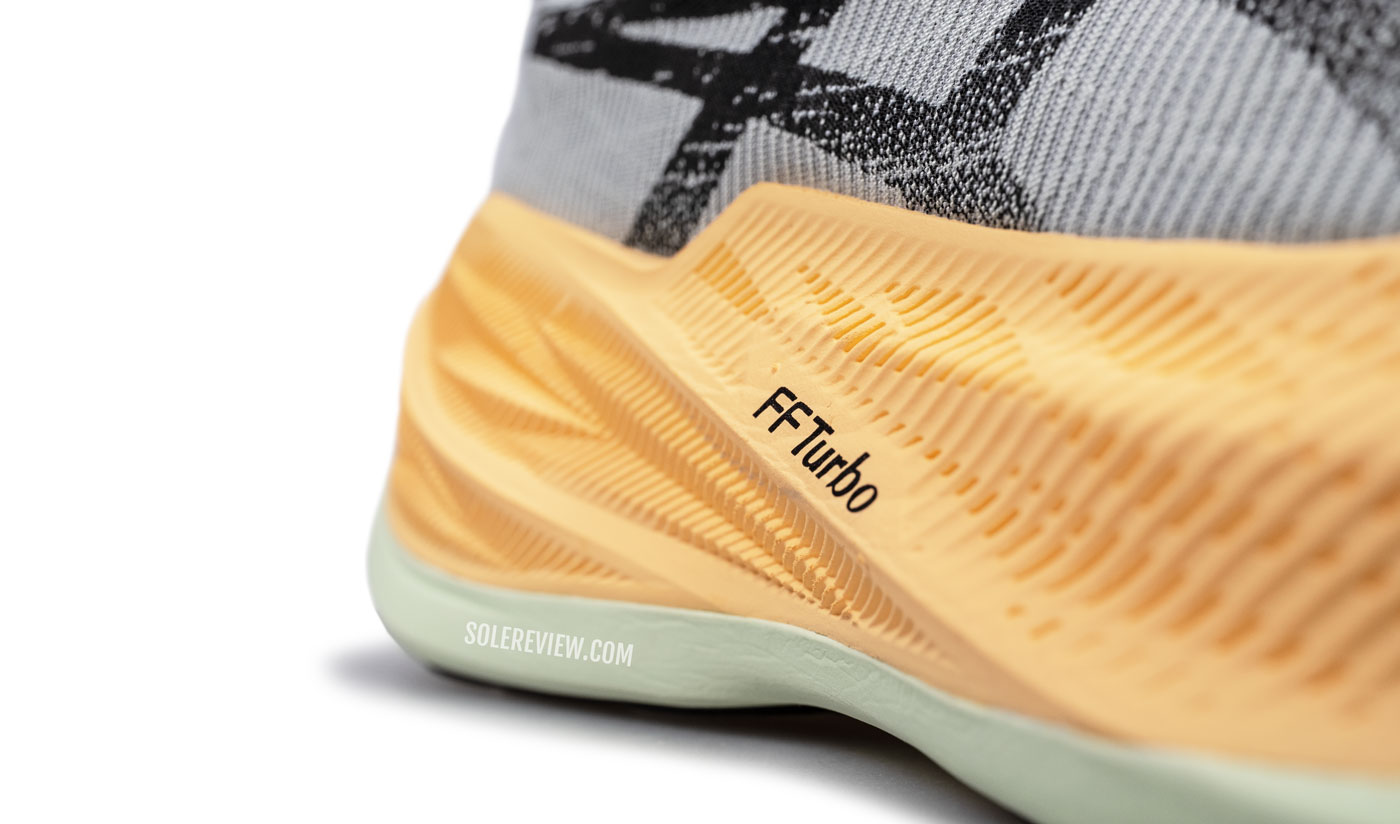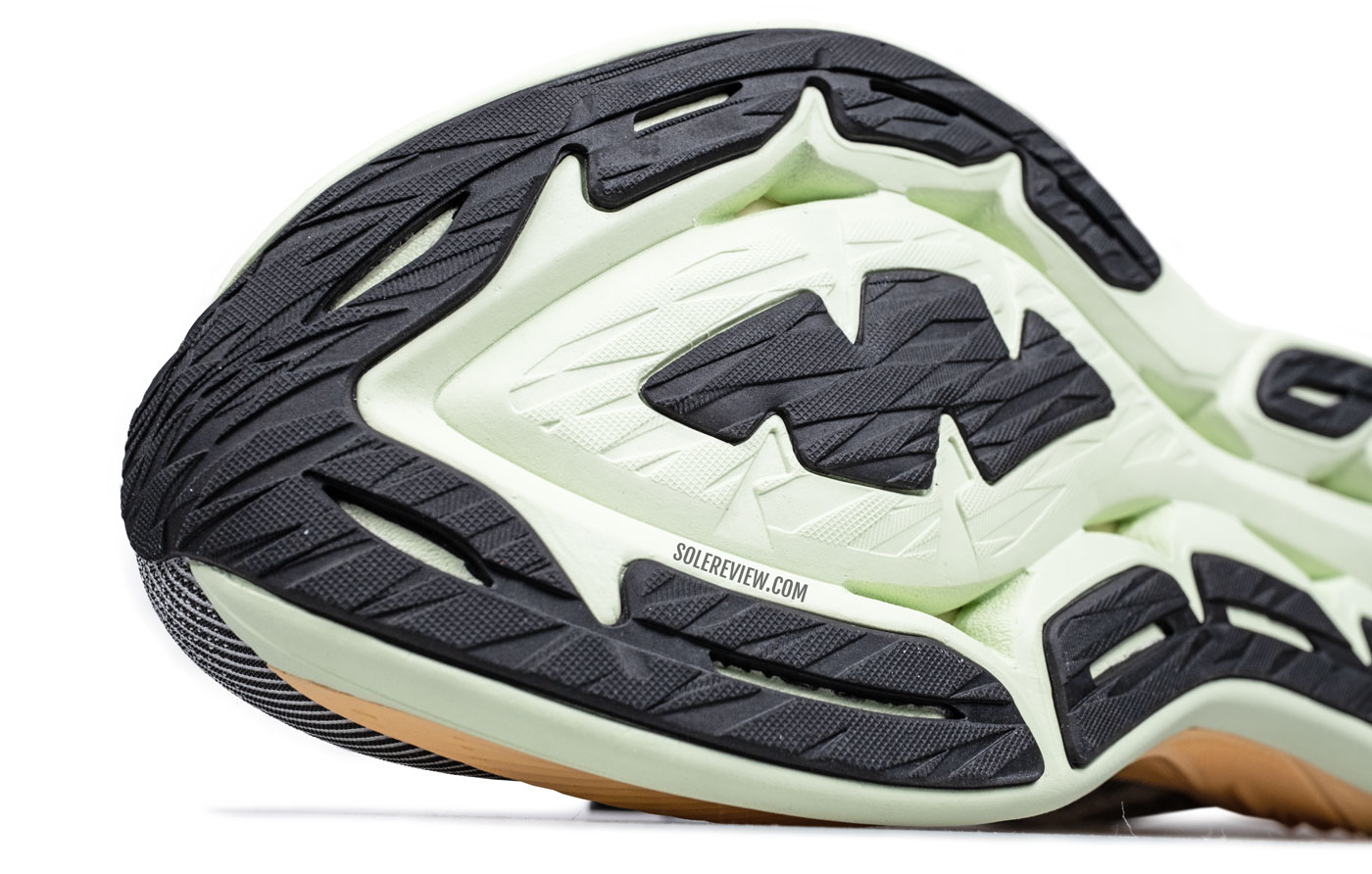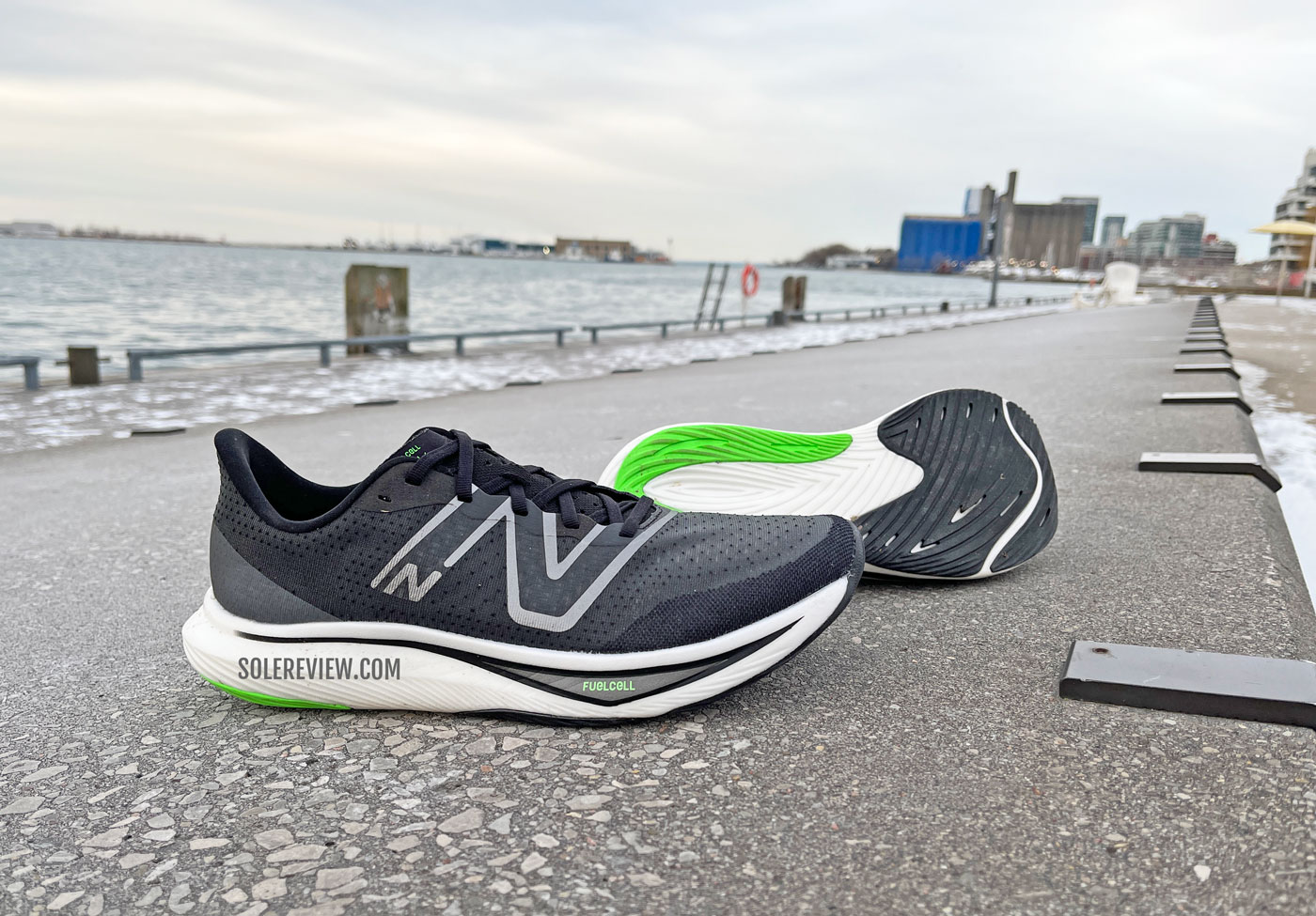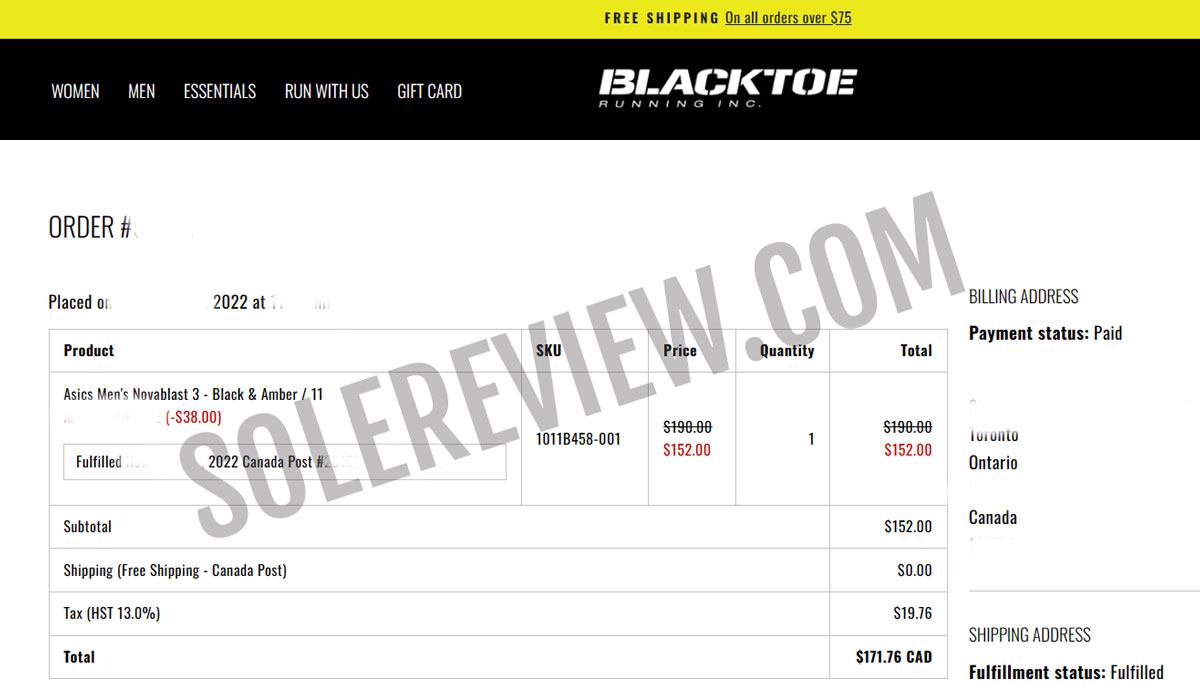
For this review, Solereview purchased the Asics Novablast 3 at full retail price. The amount is in Canadian Dollars.
In this review:
SUMMARY AND VERDICT
Kaizen is a Japanese term that’s often used in management-related literature. It’s a business strategy that aims at achieving – continuing – and incremental improvements over time.
In the Asics Novablast 3’s case, Asics has taken Kaizen to heart. That’s not true for other parts of Asics’s running shoe line – the Nimbus 25, for instance, received a drastic makeover. There’s nothing Kaizen about that shoe.
The Novablast found success a few years ago due to its unique ride character. The Novablast V1 combined a lively ride with a rocker ride – in short, it was a cushioned trainer that was not fearful of tempo paces.
While the original Novablast was tremendous fun, there were a few creases that needed ironing.
Despite its engaging ride experience, the heel stability didn’t inspire confidence. The soft midsole had deep grooves in its sidewall, so the compression travel was longer than necessary.
The other minor drawback was its longish fit. When not sized properly, the fit affected the cushioning behavior – as it shifted the ‘sweet spot’ where the foot should ideally load. We won’t get into the minutiae here, so read our Novablast V1 review for more. The Novablast 2 wasn’t all that different, despite its 2 mm reduction in the heel drop.
The Novablast 3 is excellent. Not only does it fix the rearfoot stability issues, but also fits true-to-size – almost. This removes any second-guessing about which size to buy to get the optimal cushioning experience.
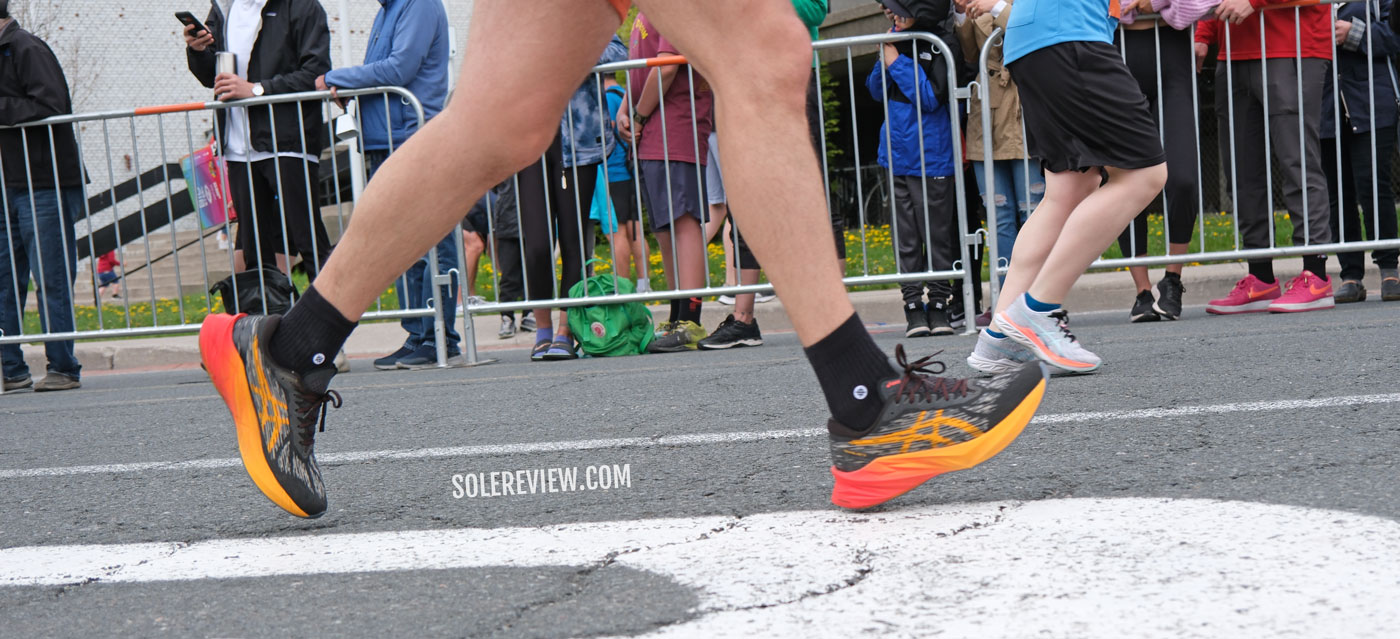
Heel strikes may not feel as cushy as the Novablast 1 and 2, but the heel stability is a noticeable improvement.
At the same time, it retains the ride comfort and tempo-friendly road manners that have made the Novablast popular.
Admittedly, the rearfoot cushioning doesn’t feel as bouncy as before due to the supportive – and thus, firmer – midsole.
In the larger scheme of things, the Asics Novablast 3 is an acceptable compromise that gets most things right.
THE ASICS NOVABLAST 3 COMPARED WITH ASICS NOVABLAST 2
If you’re looking for a quick answer, here it is. The Novablast 3 is an improved version of the last year’s model.
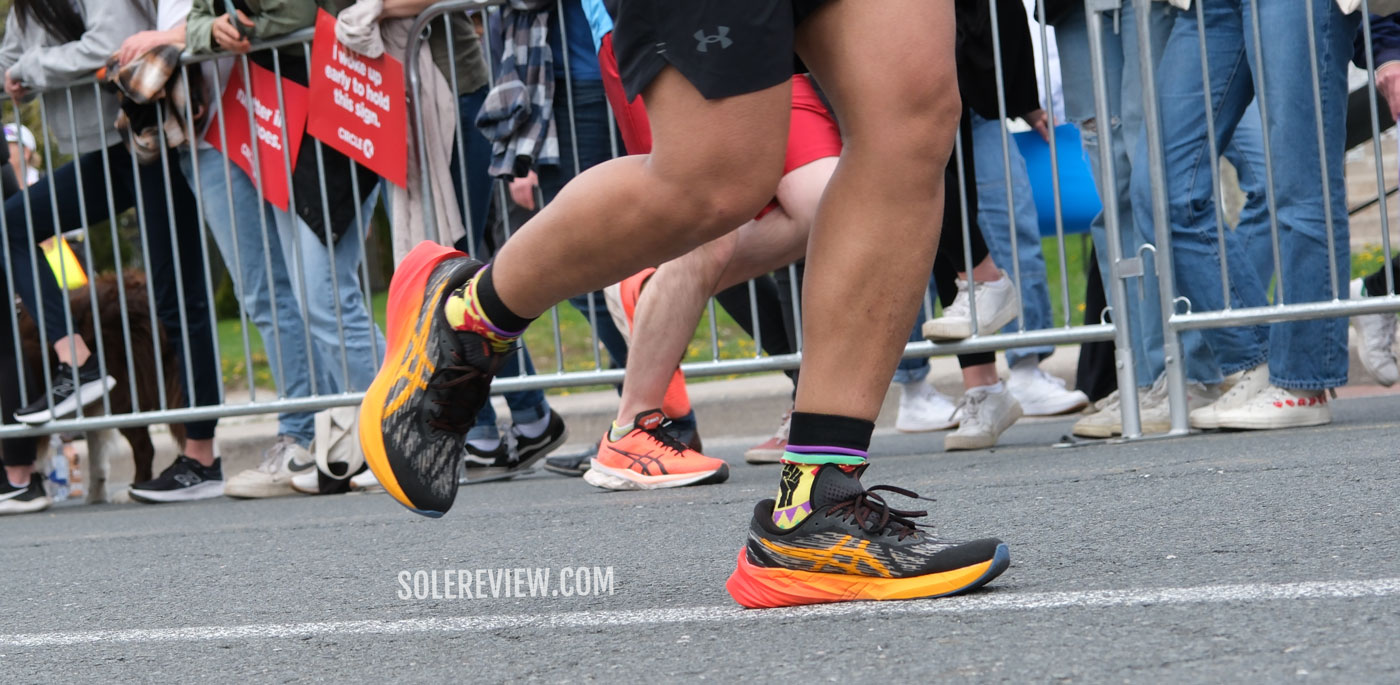
The Novablast 3 improves its stability over the previous versions. Pictured in the background is the Novablast V1.
There are three areas where the Novablast 3 outperforms the Novablast 2.
The first is the added rearfoot stability – courtesy of the refreshed midsole. The second update is the upper fit with its true-to-size profile. The third change is the lighter construction that’s helpful during high-mileage training.
The outsole grip hasn’t been great on any of the Novablast models, and the V3 doesn’t break tradition.
THE MIDSOLE DESIGN AND RIDE EXPERIENCE
Not many running shoes deliver the Novablast experience – at least not without an internal plate.
This is a somewhat surprising observation, because the underlying premise is fairly simple. The product brief for the Novablast could be condensed into a single sentence, like so:
Make a fun running shoe that’s capable of both high mileage and higher speeds (4:30 min/km, 7 min/mile, or faster) runs.
On paper, that sounds like an easy goal to meet. In reality, that’s deceptively hard to do. Ask the Saucony Endorphin Shift – a shoe that should have been as fun as the Novablast, except it’s not. The Nike Pegasus Turbo was successful once, but failed at an encore.
For a while, Skechers did a fine job in that area. The GoRun series peaked during the Meb Keflezighi era, and some of the shoes were true predecessors to the Novablast.
Skechers was one of the first to popularize the ‘Meta Rocker’ midsole profile, and it combined that form factor with a resilient EVA foam to produce a delightful ride experience. These days, Skechers appears to have other commercial priorities.
So what makes the Novablast the running shoe it is?
If you strip away the lofty marketing adjectives, then the Novablast 3’s entire character is a sum of two factors – the Flytefoam Blast foam cushioning and the forefoot ‘rocker’ profile. On the road, that equates to comfort and speed.
The midsole is made of 100% Asics Flytefoam, and there’s a lot of it under the foot. A heel and forefoot stack height of 42 mm and 33 mm produces an 9 mm offset. Unsurprisingly, the forefoot cushioning feels substantial and planted.
Inside the upper is a smooth EVA foam insole over a foam lasting. This footbed is similar to what the V1 had. On the road, a smooth insole works better if the goal is to increase responsiveness, so this is the right design choice.
On the other hand, a soft blown foam sockliner is a better fit for plush running shoes with an unhurried ride.
The Novablast’s Flytefoam Blast+ hits the sweet spot between firm and soft. There’s also a certain lightness and liveliness in the cushioning delivery. The single-density construction produces a ride quality that is smooth and consistent.
The three layers of foam work together to deliver mileage-friendly comfort. The Novablast works as a half-marathon shoe, and can go longer as well.
The cushioning isn’t particularly bouncy due to the relatively solid sidewalls, but there’s a trace of responsiveness that is recognizable from the previous Novablasts.
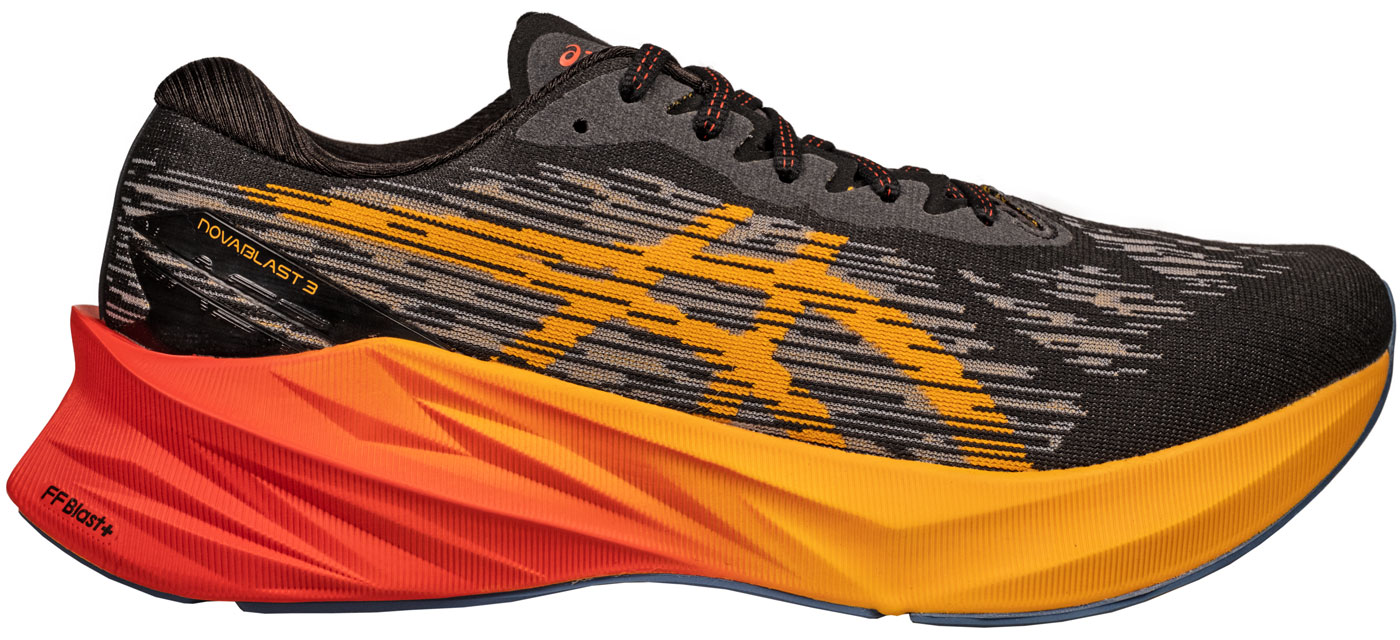
The rocker forefoot (and its high toe spring) makes it easy for the foot to ‘tip’ forward before takeoff.
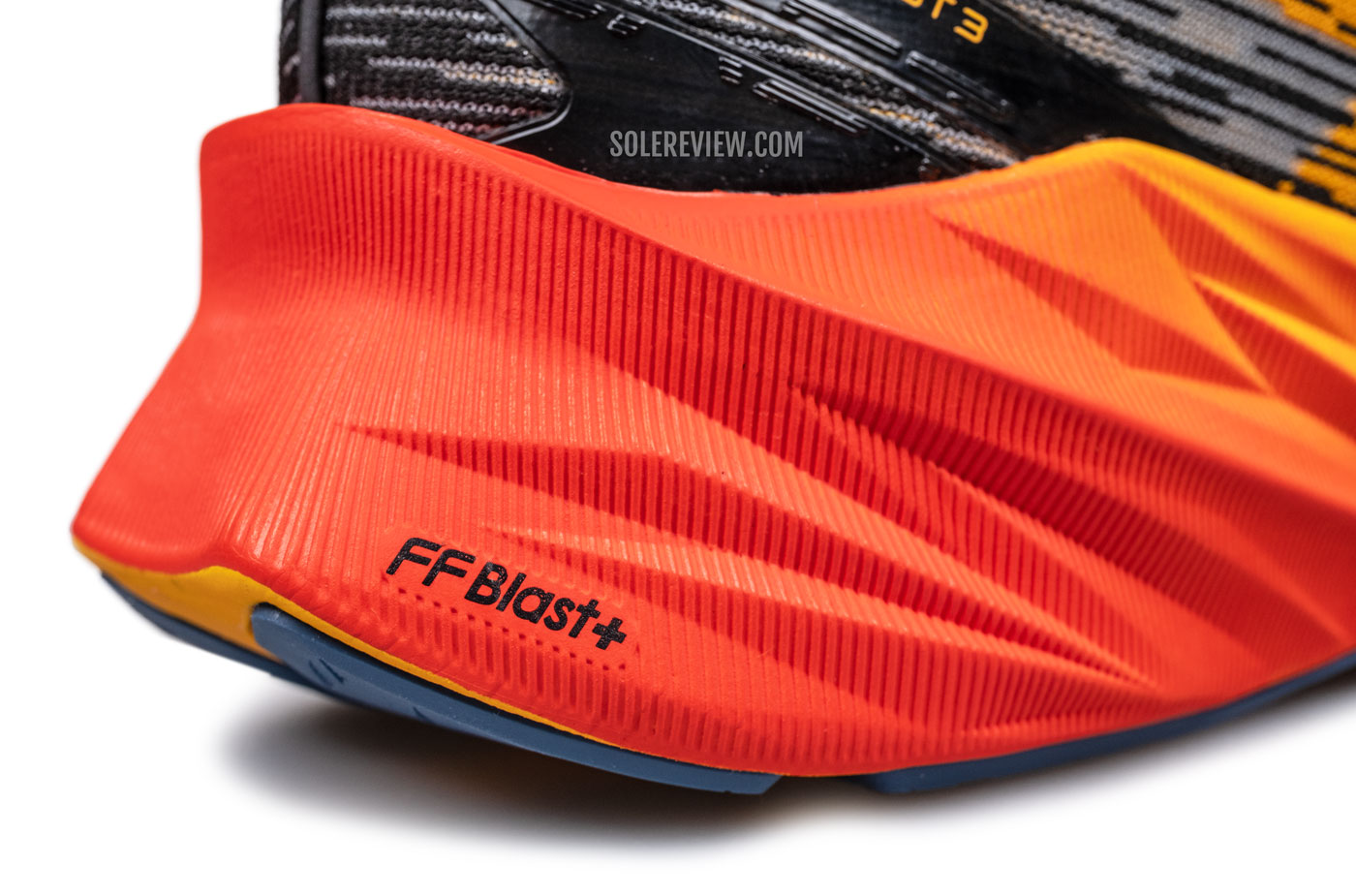
The heel spring or bevel helps with smooth transitions and also makes the Novablast midfoot strike-friendly.
The rocker profile forefoot complements the comfortable midsole by infusing a tempo-friendly character. The inflexible forefoot and high toe spring (bevel) help the foot roll forward for quicker transitions.
Here, ‘quick’ doesn’t refer to Asics Metaspeed or Metaracer levels of speed eagerness. Rather, the Novablast is a few leagues above softer neutral trainers like the Nimbus 25 in how agile it feels.
When expressed in numbers, the Novablast does well even at 4:00 min/km or 6:30 min/mile paces.
At easy speeds, there’s no performance penalty. The Novablast is very much a trainer for easy runs (5:30 min/km, 8:50 min/mile) as it is a tempo trainer.
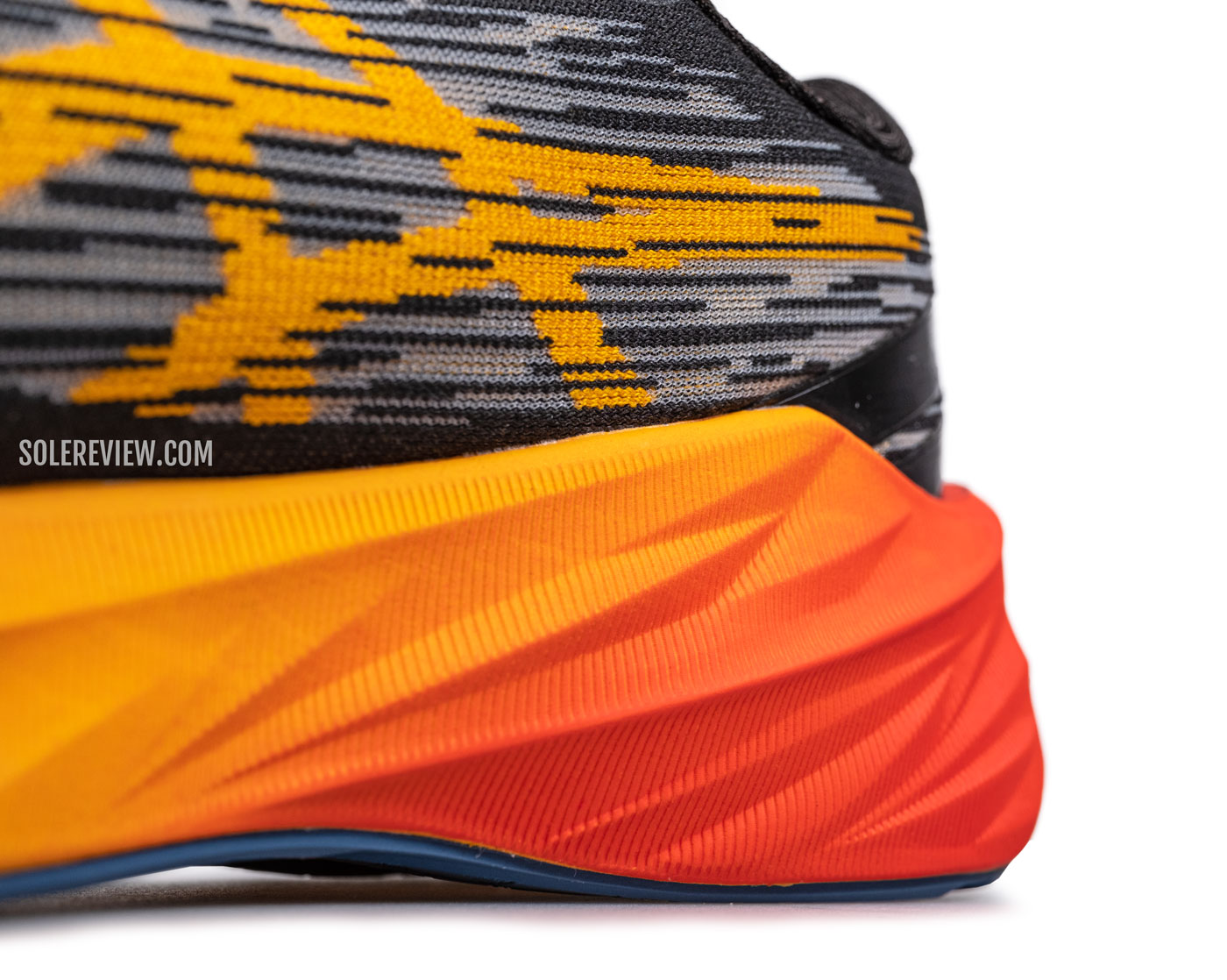
The deep grooves from the Novablast 1 and 2 no longer exist on the V3. This results in lower ‘bounce’, but greater rearfoot stability. Also, note the raised edges that support the upper.
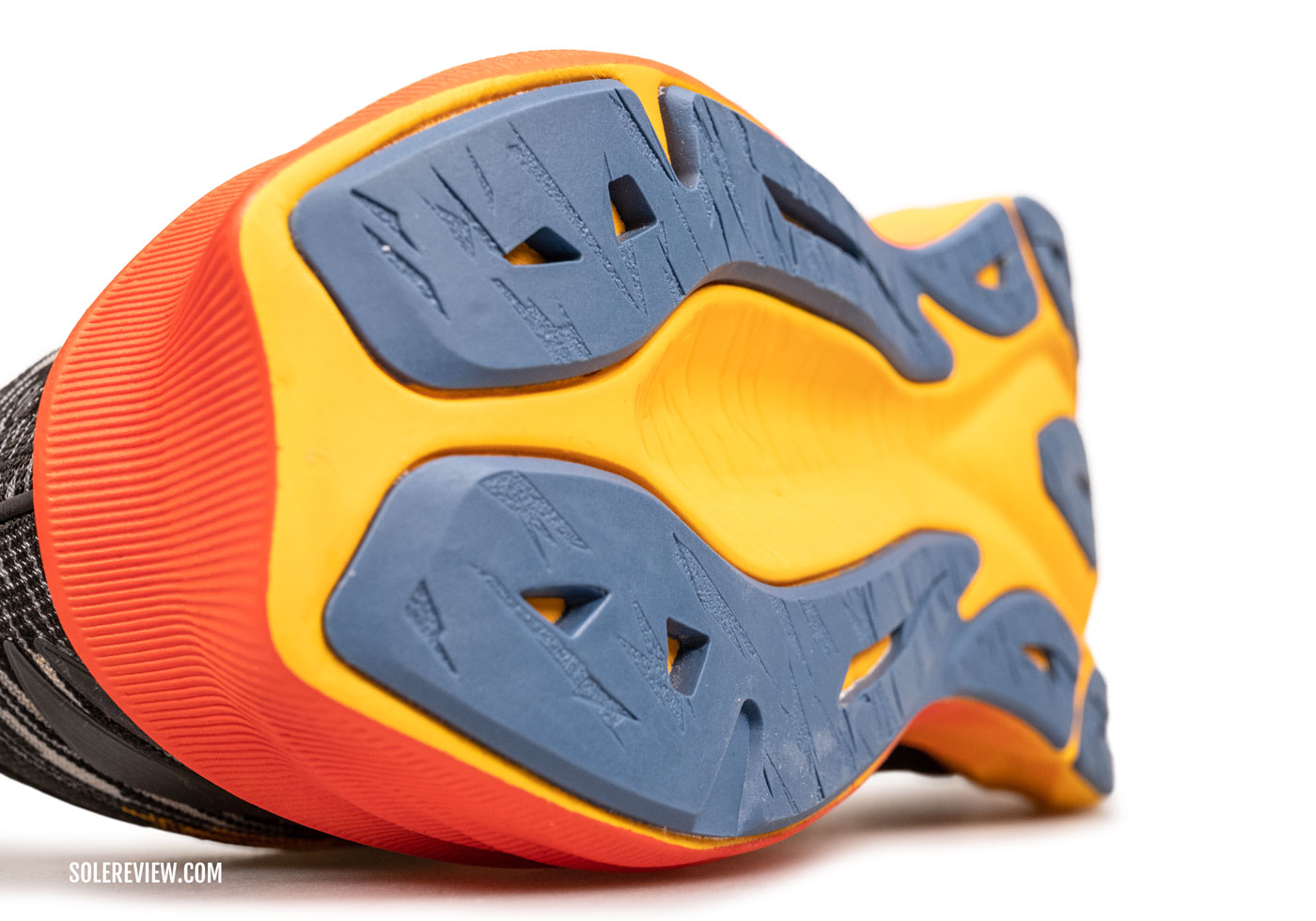
The negative space under the heel affects the cushioning comfort as well as stability – in a good way.
Unlike the first two iterations, the new midsole lacks the deep, sculpted scoops in its sidewall. The new midsole base is also wider, and the raised edges cup the upper.
This leads to substantial gains in the overall midsole stability, thus making it safe even for heavier runners.
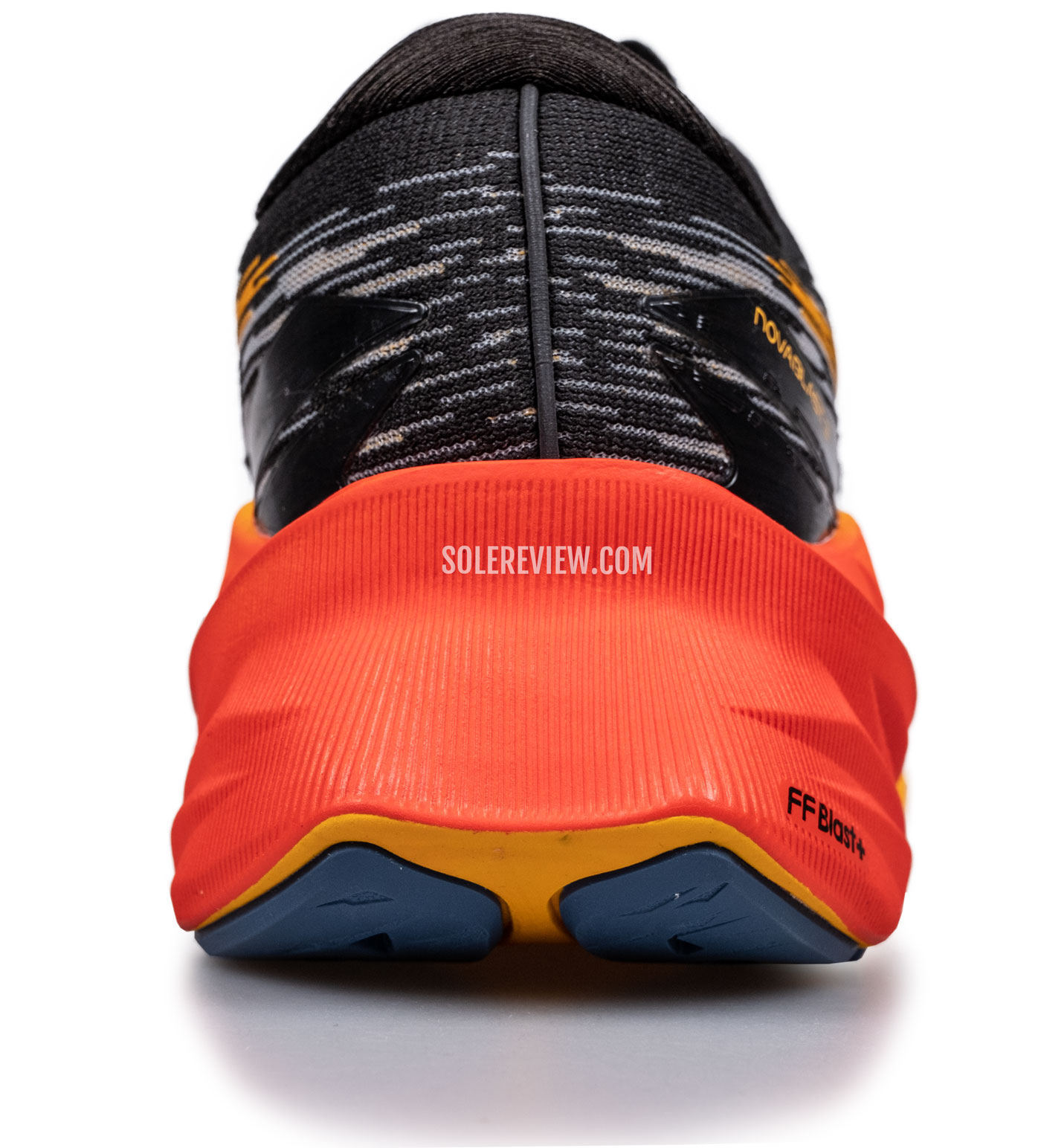
The Novablast 3 has a very neutral ride quality – the outer and inner midsole densities are well-matched.
Runners will not experience a cushioning bias – meaning that compression doesn’t favor any particular side. This is a very neutral trainer. The transition groove under the heel also helps center the weight during the loading process.
Thankfully, Asics no longer calls this feature as ‘3D space construction’, and instead opts for a simpler ‘trampoline effect’.
By the way, Solereview was one of the first in the industry to popularize this adjective many years ago, when we described the 2014 Brooks Ghost to have a ‘trampoline effect’.
The sub-par outsole traction continues to be an issue on the regular model.
On the face of it, one could point out the lack of an aggressive lug geometry or grippy rubber compound. But there are two other factors that (negatively) affect the Novablast’s forefoot grip.
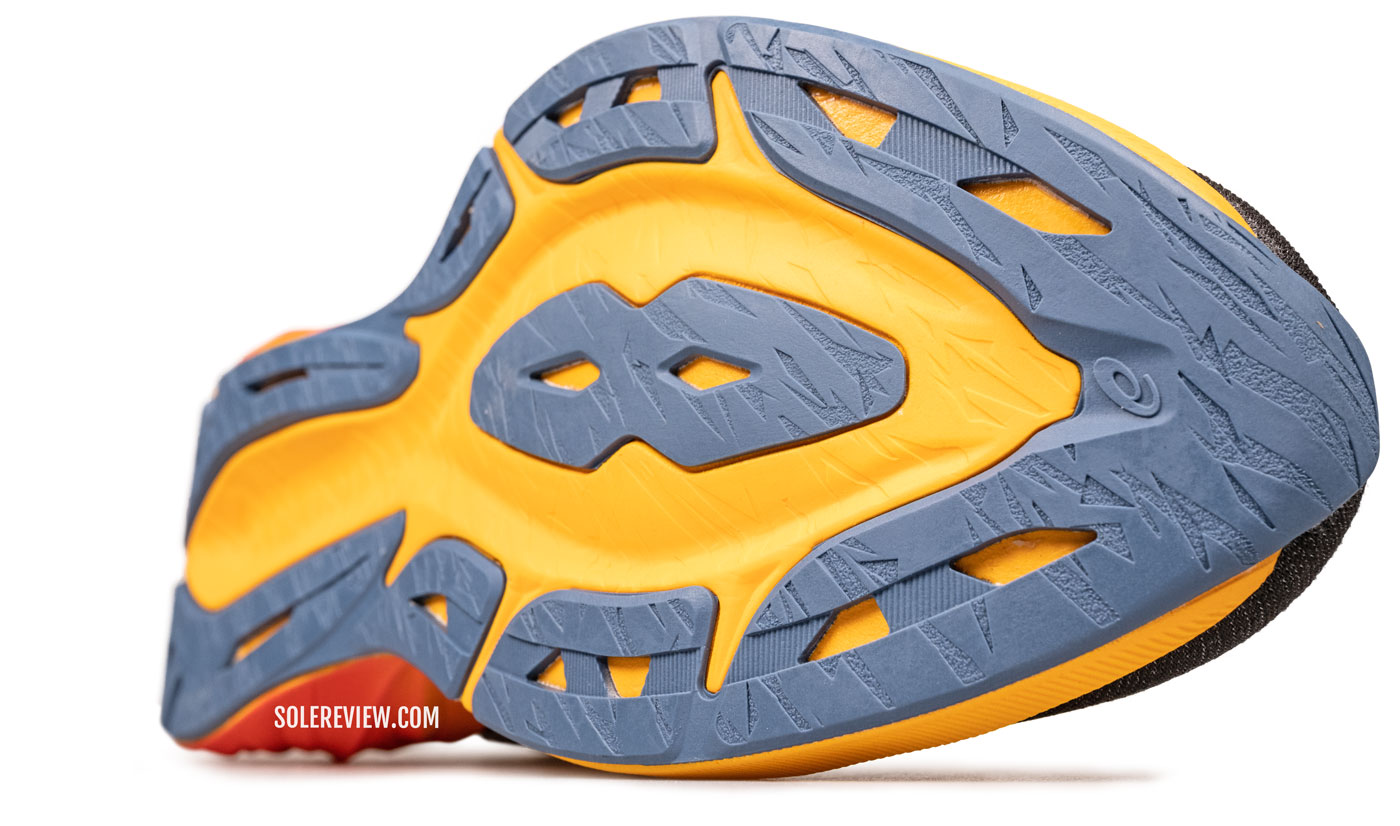
The rocker profile of the Novablast 3’s means that not all of the forefoot outsole is in full contact with the ground.
The midsole rocker shape means that half of the forefoot lug is not in contact with the ground at any given time.
The second is the firm Flytefoam midsole. But how does the midsole softness affect the outsole grip?
A softer midsole allows the outsole lugs to spread wider, thus creating a greater contact area. This is why the softer Asics Superblast grips better despite its similar layout.
There’s an easy fix. For $5 more, Asics sells the Novablast TR – a Novablast with an outdoors-oriented outsole. While calling it a trail shoe is a stretch, the defined lugs grip better than the shoe being reviewed.
There are other Novablast flavors like the ‘LE’ and ‘Platinum’, but they just have some fancy paintwork and colors.
RECOMMENDED ROTATION
There’s more than one way to build your Asics-only rotation.
The Novablast can serve as an everyday trainer, and your marathon shoe could be the carbon-plated Metaspeed Sky. For shorter 5K races and speed runs, the no-frills $90 Hyper Speed 2 is good for building pace.
Non-Asics suggestions would be the Saucony Endorphin Speed 3 (or Pro 3) for marathons, and the basic adidas adizero RC5 for 5K speed runs and races.
The Asics Superblast and Nimbus 25 also happen to be capable marathon shoe choices without a plate.
The Superblast is softer and bouncier than the Novablast, and offers greater ride comfort. The Nimbus 25 doesn’t feel as ‘fast’, but it’s a marked change from the Nimbus 24. The forefoot midsole acquires a rocker quality that’s new to the Nimbus.
IS THE ASICS NOVABLAST 3 DURABLE?
Asics Flytefoam has a good track record, and the FF Blast+ behaves closely like an EVA-blended foam. It’s good at resisting compression fatigue, and the flat outsole is also durable. The upper isn’t flimsy, so there’s an extremely low probability of mesh blowouts.
A lifespan of 400 miles is on par for the course.
THE UPPER DESIGN AND FIT
The midsole stability isn’t the only area that’s better on the Novablast 3.
On the improved upper, the sizing fits truer than the V1 and V2. It’s not 100% true-to-size, considering that there’s some extra room ahead of the toes. But it’s not overly long, and the extra space is helpful when worn with thicker wool socks.
The forefoot, midfoot, and heel offer a comfortable and secure grip. The mesh isn’t layered, and reinforced areas like the lacing panel use soft and flexible materials.
The upper achieves a happy medium between functional ventilation and three-season wearability.
The front of the lacing area is notched on both sides to make the upper easy to flex and work together with the foot. Though it’s hard to tell from the pictures, the laces are soft and easy to cinch.
Asics has always been generous in its treatment of the heel collar. That’s true for the Novablast 3, as the plush heel is packed with foam. It works together with the internal heel counter to produce a non-slip fit.
Some runners will miss the padded tongue from the Novablast 1 and 2.
While we’re indifferent to this update, the flatness of the tongue is a stark contrast to the padded heel. The mesh used on the tongue has a tiny amount of squish, but the flap could have benefited from a foam pocket or two. Asics should learn a thing or two from adidas’s adizero playbook.
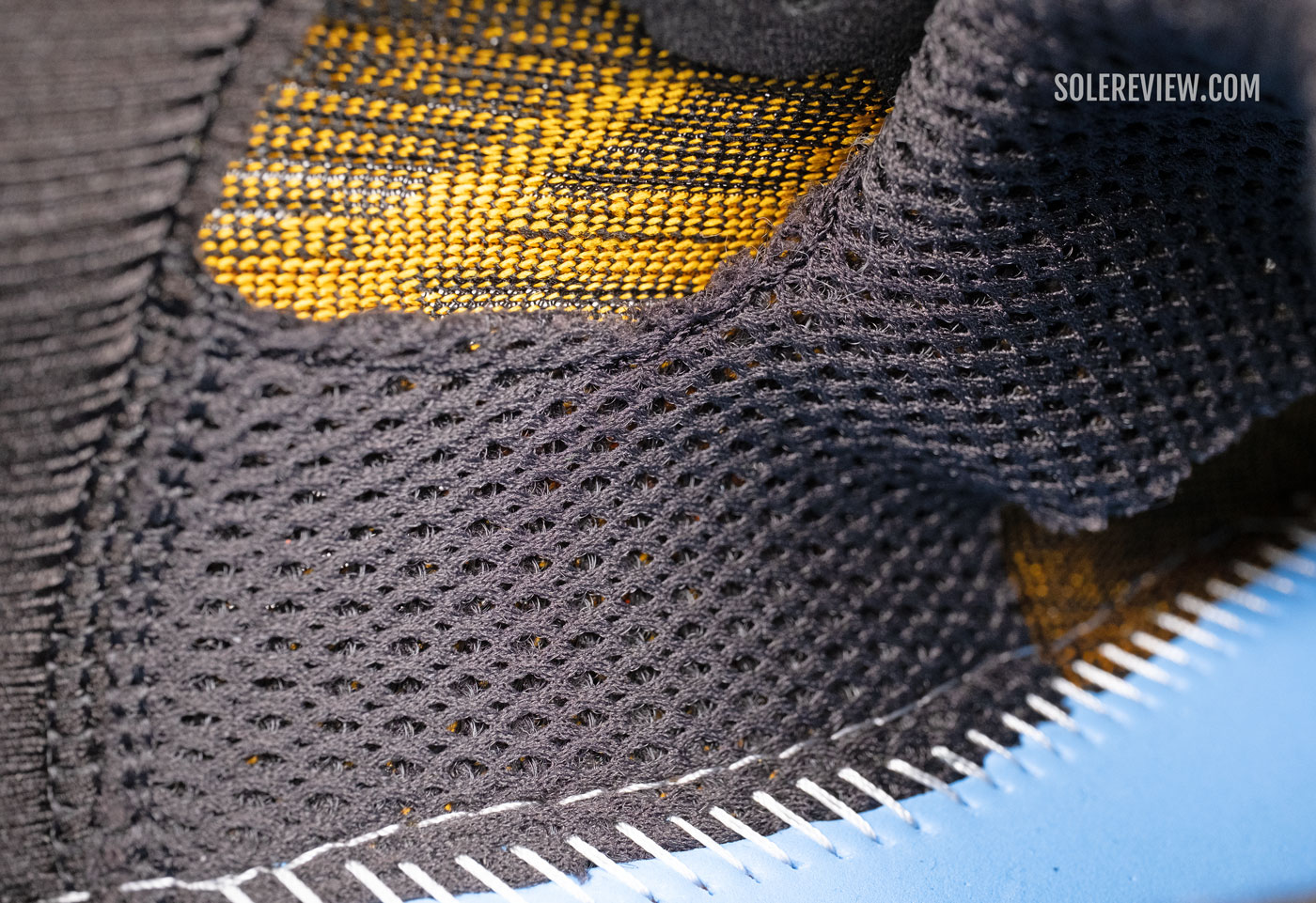
An internal gusset prevents tongue slide and increases midfoot comfort. The Novablast V1 did not have a sleeve.
Leaving aside the comfort aspect, the tongue design is very functional. A deep notch on the flap keeps it locked over the foot, and the soft edges are very comfortable. The use of the gusset prevents sliding while enhancing the midfoot fit.
Asics is now playing the Nike game by selling reflective models (Lite-Show) at a price premium, so the standard Novablast has scant low-light visibility. Only the thin strip over the heel is reflective.
ORTHOTIC COMPATIBILITY
The Orthotic compatibility is average. The Novablast uses a standard removable footbed, so it’s best to replace it with an orthotic of a matching thickness. Otherwise, an aftermarket insole will have a couple of negative outcomes.
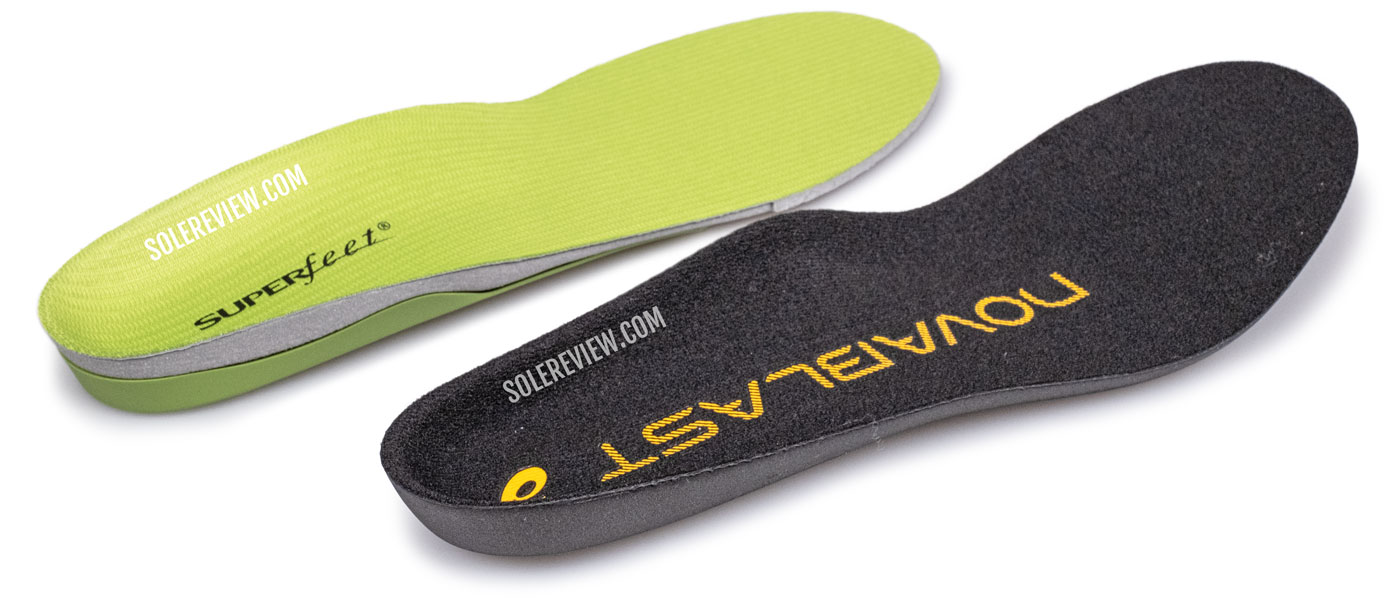
The Novavblast 3’s insole is thinner than the structured insoles such as the Superfeet Green and Superfeet Blue.
An aftermarket insole that is thicker in the heel (which they usually are) will affect the upper fit and also alter the heel-to-toe offset.
For example, replacing the Novablast’s sockliner with a Superfeet blue will not result in an optimal fit outcome. The Superfeet Green can fit, but the heel will lose some of its depth and grip.
PROS AND CONS
The highlight of the Asics Novablast is its finely-tuned balance between ride comfort and agility. This version also has better rearfoot stability than any of the previous versions.
Take-offs are easier, thanks to the rocker midsole. The mildly responsive/bouncy Flytefoam is easy on the feet, so half-marathons are perfectly within the Novablast’s capabilities.
The outsole grip is not great – a feedback that hasn’t changed since we reviewed the first Novablast.
Asics sells a reflective variant called the Novablast 3 Lite-Show, but the standard model is practically non-reflective. There’s a tiny strip over the heel, though.
With a secure heel grip and true-to-size profile, the upper fit is excellent. The tongue could also do with some padding – not all of it needs to be quilted, only the flap.
COMPARISON: THE ASICS NOVABLAST 3 VERSUS ASICS SUPERBLAST
The Asics Superblast is exactly what it sounds like. It’s the Novablast, but loaded with performance-boosting upgrades.
Instead of a Flytefoam Blast+ core, the Superblast uses Flytefoam Turbo – a softer, lighter, and bouncier cushioning material that’s used on the Metaspeed. The firmer Flytefoam Blast+ also exists, but only as a base layer.
As expected, the ride experience benefits from the superior components.
Despite the absence of a plate, the rocker profile makes it a speed-friendly shoe. It’s objectively better than the Novablast for long-distance runs, so if you want a cushioned trainer without a plate, the Superblast is a solid pick. It’s lighter and more comfortable for high-mileage training than the Novablast.
Interestingly, the outsole traction is much better than the Novablast – despite sharing a similar outsole layout. Here, the softer midsole does a better job of pinning the rubber outsole against the road. This creates a larger contact area, with the byproduct being better traction.
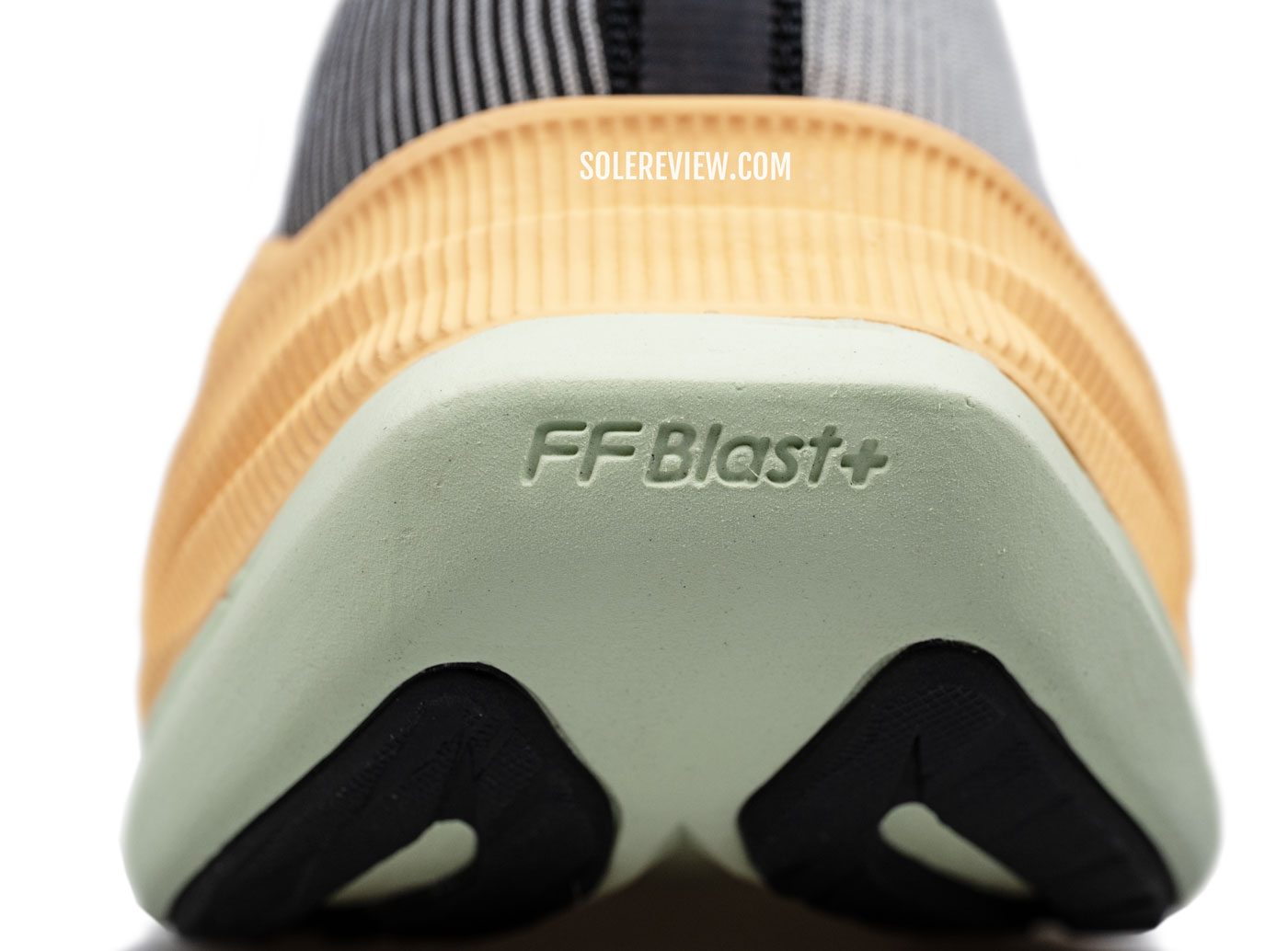
The 2023 Asics Superblast is a fun take on the Novablast. The soft Flytefoam Turbo works perfectly over the firmer Flytefoam Blast+ base.
Here’s another way to look at the Superblast. It’s like a higher cushioned version of the Nike Pegasus Turbo 1 and 2 that had a soft, lightweight, and springy foam on top, and a firmer material below. We’re not talking about the Pegasus Turbo Next Nature – Nike botched that one.
All the extras come at a significant upcharge ($200 versus $140) over the Novablast.
SHOES SIMILAR TO THE ASICS NOVABLAST 3
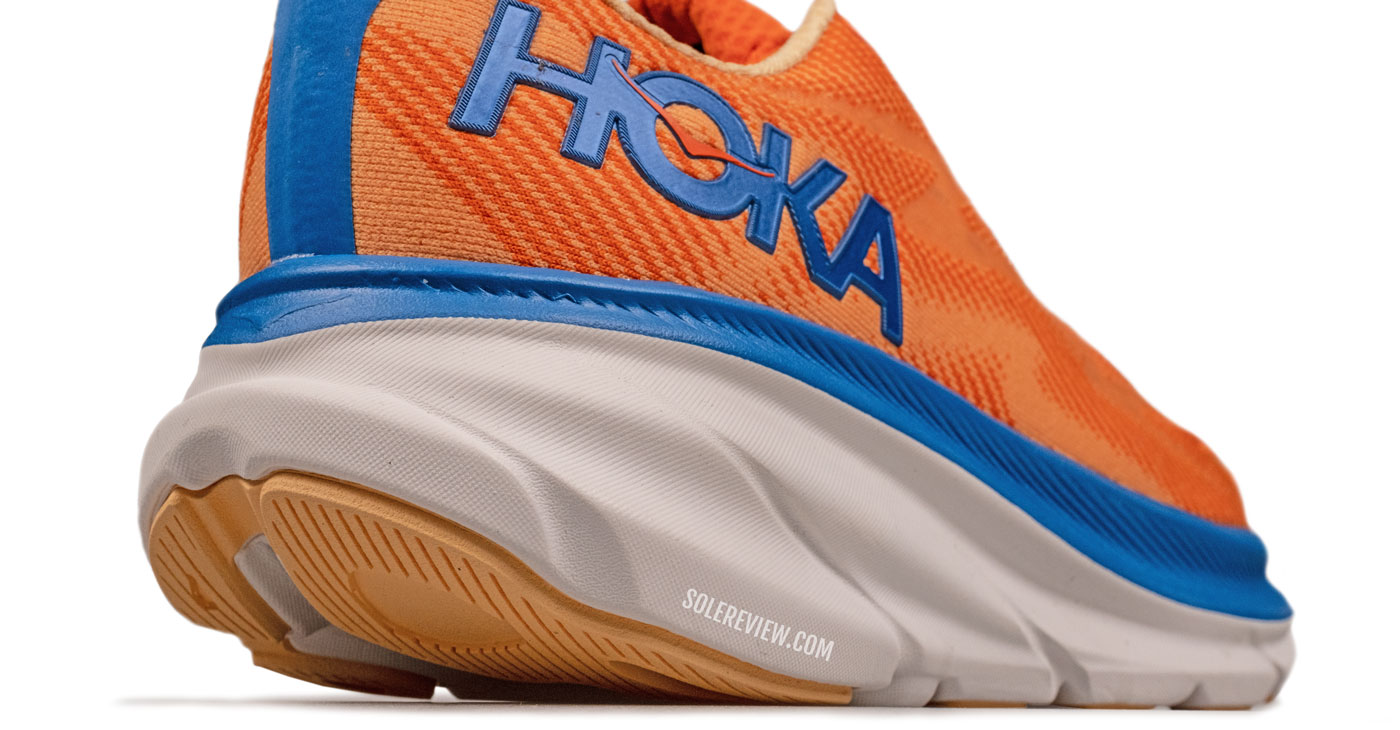
The Hoka Clifton is one of the original cushioned rocker trainers. That alone places it in the same category as the Asics Novablast.
Besides the Asics Superblast, what other non-plated running shoes compete with the Novablast?
In this section, we’ll briefly discuss running shoes that offer a cushioned ride without compromising speed. So while these shoes do not necessarily share a similar form factor with the Novablast, they deliver a comparable ride experience.
The Saucony Endorphin Shift 3 hasn’t reached its potential yet. Its firm ride is cushioned, yet feels ‘flat’ in comparison to the Novablast. On a related note, even the Saucony Ride 15 is an option.
The Hoka Clifton was one of the original tempo-friendly distance trainers. In its ninth year, the Clifton hasn’t changed much. It still relies on a rocker-profile EVA foam midsole to produce its peppy ride character.
With their blend of soft cushioning and responsive pep, both the Hoka Mach 5 and New Balance Rebel V3 also compare with the Novablast.
Given the difference in how both these trainers are constructed, we’d only recommend the Mach 5 and Rebel V3 for distances upto a 10K. For anything longer, the Novablast would be a better play.
Do you own this shoe? Improve this review by sharing your insights – submit a review here.

